April 10, 2007
Ubiquitous Media: Asian Transformations

CALL FOR PROPOSALS
Ubiquitous Media: Asian Transformations (Tokyo July 13-16,2007) :: DEADLINE: April 26 :: Plenary speakers will include: Rem Koolhaas (OMA Rotterdam); Mark B.N. Hansen (University of Chicago); Katherine Hayles (University of California at Los Angeles); Shigehiko Hasumi (Former President of The University of Tokyo); Ken Sakamura (The University of Tokyo); Barbara Maria Stafford (University of Chicago); Friedrich Kittler (Humboldt University); Akira Asada (Kyoto University); and Bernard Stiegler (Centre Georges-Pompidou, Paris).
Today media are increasingly ubiquitous: more and more people live in a world of Internet pop-ups and streaming television, mobile phone texting and video clips, MP3 players and pod-casting. The media mobility means greater connectivity via smart wireless environments in the office, the car and airport. It also offers greater possibilities for recording, storage and archiving of media content. This provides not just the potential for greater choice and flexibility in re-working content (tv programmes, movies, music, images, textual data), but also great surveillance (CCTV cameras, computer spyware, credit data checking and biometrics). The media, then, can no longer be considered to be a monolithic structure producing uniform media effects. Terminology such as 'multi-media,' and 'new media,' fail to adequately capture the proliferation of media forms. Indeed, as media become ubiquitous they become increasingly embedded in material objects and environments, bodies and clothing, zones of transmission and reception. Media pervade out bodies, cultures and societies.
These ubiquitous media constitute our consumer and brand environment. Their interfaces and codes pervade our bodies and our biology. They pervade our urban spaces. They are ubiquitous in art, religion and our use of language. Yet from another angle art and language are, and have immemorially been, media. Media are about the physical, algorithm and generative code; but they are also immaterial and metaphysical. Communication is about channels and hardware/software; but communication is also about communion and community. Media deal in images: that is in the material; but their idiom is also symbols and the transcendental.
To theorize about today's world, we evidently need to theorize media. Yet to theorize media also means we need to focus on how technological media are used in everyday practices. Not least, we need to address the question of the relationship of media practices to politics. This opens up questions about the formation of informed publics, new social movements and media events, not just the alleged need to combat media terrorism, nationalism and crime. Suggesting further questions about the power and influence of transnational media, intellectual property rights and openness of access. Raising issues of generativity, creativity and critical intervention.
Asia - East Asia, South Asia, and increasingly crucial, the Middle East - are becoming sites for these processes. Global geopolitics has been restructured by the 'rise' of China and India and the turbulence of the Middle East. With concomitant transformations of the role of the West and Japan, this conference becomes also a question of 'ubiquitous Asia.' These transformations are producing new trans-Asian culture industries, social movements and activism. At stake are a set of transformations of Asian culture(s) itself - of language, and modes of cultural thought and being. We will seek to address these uestions of media transformations and their relation to social and cultural processes in a number of plenary sessions, paper sessions, round tables and events.
About Organizers
This conference is organized by Theory, Culture & Society and Interfaculty Initiative in Information Studies / Graduate School of Arts and Sciences, The University of Tokyo.
Posted by jo at 11:39 AM | Comments (0)
March 25, 2007
NOEMA

Ideas + Survey
Generic Infrastructures [2] by Rob van Kranenburg: Today we are in the worst situation imaginable. Our global and undisputed computing paradigm posits that computing processes are successful only in as much as they disappear from view. Our design focus is ever more following Philips untenable but seductive ‘sense and simplicity’ resulting in the-bug-as-a-feature-design of the Ipod Shuffle. Our educational system is following this systemic hide-complexity strategy that favors the large industrial labs, IT conglomerates and above all their clinging to notions of IP and the patent that are firmy tied to their notions of doing business and making money. And our users, us? We are YOU, the most influential person of the year 2006, according to TIME Magazine. You fill the Wikipedia entries in your spare time, you blog your daily activities, you co-bookmark on de.l.i.c.i.o.u.s, upload your photos to flickr, you buy mating gear in Second Life, and mark your position on Plazer or Google Earth. You fill out the forms. Isn’t it time you start questioning the principles behind the formats? And, to make matters even worse, your naïve ideas of sharing are corrupting notions of privacy, transparency and informational architecture symmetry.

Ludium II - Synthetic Worlds and Public Policy by Edward Castronova: Synthetic worlds – million-player online environments with genuine markets, societies, and cultures – are exploding in size and significance. Real world governments around the globe are beginning to grapple with their implications in the areas of taxation, intellectual property laws, consumer rights, addiction, violence, and more. Should synthetic worlds be controlled by developers, or by governments, or both? What about the rights of users? What general norms should legislatures and courts follow? More NOEMA >>
Posted by jo at 01:33 PM | Comments (0)
February 23, 2007
Experimental Gameplay: Toward a Massively Popular Scientific Practice
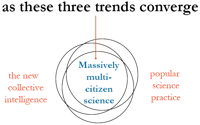
Massively multi-citizen science is almost here
Can a game developer be nominated for a Nobel Prize in one of the sciences by the year 2032? That's my plan, which I presented this past weekend at the annual meeting of the American Association for the Advancement of Science. You can download the slides from my talk, or read the related research paper (hot off the press!), or peruse some related links, on my AAAS webpage here. (Or see what Newsday took away from it here.)
My goal over the next decade is to support the development of a massively multi-citizen science through massively collaborative games (think: alternate reality games with real-world data embedded inside.) So in the near future, when the most creative, collective-intelligence gamers are grinding away 10, 20, 30, or more hours a week, they're grinding on real scientific research problems wrapped inside a yummy fictive or fantasy shell.
Yes, I am calling for a truly popular scientific research practice that engages the global public in hands-on, brains-on collaboration, via sites Citizen Science and Amazon's Mechanical Turk and through immersive, story-driven play. Amateur participation + a creative commons for science literature + the stickiness of a well-designed game and well-told story = radically interdisciplinary mash-ups accessible to lay people and productive of real scientific insight.
Sound crazy? No way. This is seriously possible, and plausible. Here's three reasons why:
1) Science practice itself is increasingly leaning toward a kind of collective intelligence, amateur participation. You can read about it in the incredible Institute for the Future report: Delta Scan: The Future of Science and Technology, 2005-2055.
2) Meanwhile, there is no doubt -- as I argue in my new 50-page case study for the MacArthur foundation -- that alternate reality gamers are doing real CI investigations that would fully prepare them for real-world collaborative research. Their gameplay is already fundamentally a CI scientific effort to undertand fake (fictive) data. I'm just proposing that we shove some real scientific data in there, while they're at it.
3) And perhaps most importantly, as Sean Stewart - the original and most esteemed alternate reality storyteller around - has famously said: "I do NOT assert that [alternate reality gaming] is the first, or greatest, example of massively multi-player collaborative investigation and problem solving. Science, as a social activity promoted by the Royal Society of Newton's day and persisting to this moment, has a long head start and a damn fine track record.... We just accidentally re-invented Science as pop culture entertainment."
So, yes, If this sounds interesting, get the slides. And here are a couple of other sites to get you thinking: "Fostering Scientific Habits of Mind in the Context of Online Play" and MacArthur Spotlight on Digital Media & Learning.
If you want to propose a data set, scientific problem, or research focus for a massively multi-citizen science game, or if you want to be notified when there's such a game to be played, email me at jane @ thenameofthisblog dot com. [bblogged by Jane on Avant Game]
Posted by jo at 06:00 PM | Comments (0)
February 06, 2007
Takashi Matsumoto on
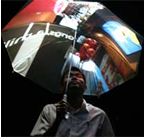
Ubiquitous Content + Pileus: The Internet Umbrella
"[...] "Ubiquitous Content" is an idea of a new design objective of our lives in the post-PC era. In 20th century, a notion of media contents has been meant contents like movies, music, animations, video games etc. Figuratively speaking, such contents were entities supplied in containers designed as "boxes". But now, a spread of networks and a realization of ubiquitous computing technologies are going to change those styles of media. The container is not like a "box" any more: It will change its forms freely to give us advanced computer augmentations in a specific context and it will be sometimes invisible embedded into our environments. It is more appropriately called Ubiquitous Media and it will be a new style of media. When we design such Ubiquitous Media, we need to think about the container as our environments in which many things are cooperating rather than a single hardware, a single software or a single standard. Users will not need to be conscious of those medias, therefore such containers emerge for users as "their lives" themselves. "Ubiquitous Contents" are contents for such media. Those must be "experiences" in "their lives".
As Ubiquitous Content project focuses on our lives and experiences, all things in our everyday lives are targets of the design. The 10 Laboratories of KMD are working on this wide subject from different perspectives....
Pileus is the most exciting project for me right now. This work is designed in a team with Sho Hashimoto, who has a unique engineering skill in the lab. We started this project in a kick-off camp of a spring semester in 2006. the initial concept and the first scenario movie were completed in just 3 days of the camp.
We have many rain in Japan. So the umbrella is one of the closest article of everyday use, but it is also a bulky article in such a climate. Traditionally we have been feeling many kinds of air and mood in a rainy day, and we wanted to expand that feeling to be more fun and vivid with the re-design of an umbrella. From that perspective, we came up with the idea of umbrella to take photo-logs and to browse internet contents in a rain. Me and Sho already took notice of that we can provide many kinds of services in a real world with Web2.0, and also had a technological vista to mash-up those with a mobile hardware. Additionally, it was another target that this can be the first example of a hardware mash-up to indicate a new economic solution for mobile gadgets joining into an economy of Web 2.0. We do not want a small "Cellphones" (Smartphones, whatever) squashing up many functions inside, but we re-designed an object of everyday use from scratch to be mashed-up with web services.
At the end of last year, we founded a spined-off LLC for the project, and we are thinking how it will go a business exit.
As the ideology of the design of Pileus, we would like to show that design is not about its shape any more; an apt assortment of modules and interactions are more important factors for the design. So, our prototype is showing off the circuits to see how modules are combined rather than covering it. Some people suggest us to give a beautiful surfaces for it as a "design", but that is not what we want to do now, we are meticulous about the interaction of information visualizations on the screen though. Fortunately, this rugged look is loved by many audiences at demo sites.
As an exclusive info, we have builded a new version of Pileus with GPS. A new function with GPS is geo-tagging of photos taken by Pileus. It will help to users to check and share records of their walks in the rain. Another function is a map display of an area. This will be used for a big-screen navigation in an umbrella, and it will be able to show local pictures and local ads are loaded on the umbrella. Of course, this function is also realized by a mash-up technique. Now we are using Yahoo! Maps API, but we may switch it to Google Maps API because Japanese map on Yahoo! maps has bad scale ratio. We are going to go an experiment in a city in a rain, however, unfortunately we have had few rainy days this year yet... [ from Regine's interview on we-make-money-not-art]
Posted by jo at 01:07 PM | Comments (0)
January 23, 2007
Everyware
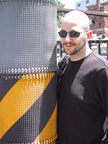
An interview with Adam Greenfield
Regine and I interviewed Adam Greenfield on WMMNA. The interview was about Mr. Greenfield’s book “Everyware: The Dawning Age of Ubiquitous Computing”, how it has been received, why such a name, what were the implications and how designers should have a voice in the discourse about everyware/ubiquitous computing…
Some questions were more specifically addressing issues that I tackle in this blog, about space/place and their relationships with technology design. If you want to read the whole interview, I encourage you to go to WMMNA.
It’s been one year that I regularly exchange with Adam through IM and meetings at like Nepublics or CINUM. So these bits might reflects some of the discussion we have (we did not address his love for the Citroen DS). Besides, if you’re interested in knowing more about the personnage and listening to his thoughts, he’d be at LIFT07 in a panel about ubiquitous computing.
NN: It’s been a while that the book has been released. After those few months, when you look back and think about the reactions and the debate it had fostered, what are the main issues that emerged? Where there unexpected discussions? If you had to add new parts in that book, what would it be about?
AG: Oh, god. I’d probably write a completely different book now. It’s not so much a question of new material, although there’s inevitably a wealth of more up-to-date information that we could profitably discuss, as what I’d want to leave out. The thesis on mash-ups, for example, which is the surviving third of a much longer argument about the decentralization of technological development, and doesn’t make all that much sense in its shorter version.
At that, I guess the thing that’s surprised me most in terms of the response is how consistently readers have said, essentially, “OK, you’ve convinced me that this stuff is going to happen, is happening. You don’t need all this material in here laying out this argument in detail. I buy the premise.” So what I’m hearing is that I probably could have trimmed out long stretches of Section 6, parts of which are the most technical in the book, the most rapidly obsolescing and the weakest in terms of their contribution to the overall argument.
As to that argument, it’s gotten a warm response from people in the field; in particular, the reception I got when I presented on the Everyware material at PARC itself was extremely gratifying. There have been exceptions, of course. Anne Galloway has expressed very clearly her distrust of all a priori design guidelines, or of anything that tends to universalize or genericize, and to some degree I think that’s fair comment; Victoria Bellotti at PARC, if I understood her correctly, seemed to feel that the sorts of graphic identifiers for information gathering activities called for in the book would likely be dangerously reductive or misleadingly incomplete, worse than no notification at all.
And as to the reactions of those not in the field? I still can’t tell. Even after ten months in the wild, I don’t think it’s found its audience.
NN: One of the most striking issue I am interested with regards with your book, Adam, is how “everyware” relates to the way people experience “space and place”. The pervasiveness of the technologies, you describe can lead to possible changes. Do you think they can reshuffle our relation to the spatial, environment and our spatial behavior? and how? Do you think, everyware, as a technological disrutpion, can create new affordances, in the environment (as with lifts, phones and cars)?
AG: Can it? Sure it can. And if it can, will it? You bet. Whether it should is something that we’re going to have to figure out on a case-by-case basis.
Take wayfinding systems, for instance. At first pass, enhancing cities with ambient locational cues, installing a layer of technology to ensure that people always know where they are and how to get where they’re going, seems like what we’d call a “no-brainer” here in the States - just a situation where the proposed intervention is transcendently, self-evidently a Good Thing.
But we know that nothing ever comes for free, that there will be costs and even revenge effects associated with this technology. Should such a thing ever come to pass in any big city, I’ll tell you right now that some people will rely on the ambient wayfinding interface at a moment when they should have been paying attention to the evidence of their own senses, and they’ll let the system lead them into a bad outcome of one sort or another. You don’t have to be any kind of a futurist to know this: it happens with GPS right now!
Will this occasional default add up to more hassle, inconvenience and pain than the system is otherwise saving its users? Hopefully not - I mean, that’s to a great extent the job of the interaction designer, to keep all that to a manageable minimum. But that’s just at the individual level. Beyond that, we must never lose sight of the fact that informatic systems of the type we’re discussing are always already social, and will have macro-scale social consequences as well. And whether or not we’re ready for that and we’re willing to accept all of the implications with open eyes is a discussion for the whole community to have, not merely designers.
NN: Now that we have talked about those spatial issues, how do you articulate these questions with architecture and urban planning? Bridges between the field of User Experience, Interaction Design, Architecture and Urban Planning will surely be relevant. This means that those disciplines will have to create, dialogues; what topics/nodes/issues do you see as potentially important
for that matter?
AG: At the rawly technical level, the fusion of mainstream architectural discourse with that of networked, ambient informatics is already beginning to happen, with the first Web-native generations beginning to pick up their architecture degrees. These are theorists and practitioners for whom the virtual and actual are closer still than two sides of the same coin.
But your point is very well-taken. Just because architecture is digitally enhanced won’t necessarily make it usefully or usably so; compassionate interaction design, sound information architecture, and careful attention to the quality of user experience are hardly universal even in the informatic sphere. A Zune is not an iPod, Suica is not Octopus, a Delta Airlines e-ticketing kiosk does not look or sound or feel like a jetBlue kiosk. So how much more difficult is it likely to be when interactive functionality is seeded everywhere in the built environment?
One issue that leaps out at me, anyway, is that architecture and informatics have different speeds. If you were to superimpose digital technologies over Stewart Brand’s famous shearing layer diagram in How Buildings Learn, you’d conclude that all but the deepest network standards and protocols evolve as rapidly as his “stuff.” Your platform of choice, its operating system, the browser or mail client version you use, your relationship with your ISP and your mobile-telephony service provider - all of these will change a dozen or more times in the course of a decade, certainly more often than people tend to change their furniture. In some easily foreseeable cases, new firmware builds for embedded domestic systems might be pushed nightly. And yet, barring the advent of some particularly advanced adaptive building technology, walls and floors and windows pretty much stay where they are.
So by and large, you have two different development communities, the architectural and the informatic, that have very different internal gearings, as it were - different orientations toward the flow of time. And again, you don’t have to be Nostradamus to predict that this will occasion a stumble or two as architecture is increasingly invested with information technology. [posted by Nicolas on pasta and vinegar]
Posted by jo at 02:41 PM | Comments (0)
December 28, 2006
Mary Mattingly

disturbing beauty
... ok, the threat by mobile phones (to which she refers) just recently has been dismissed as no longer relevant, but nevertheless there are interesting relations and a fantastic worldview to be discovered at Mary Mattingly’s project website. [link to Mary Mattingly: Second Nature – a text on M. Mattingly’s photography.]
She developes a scenario which emerges around a ‘disastrous beauty’ according to an imagination where our actual and eventual technological developments are brought together with to-come-ecological changes. It all together impresses through the beautiful set-up and the quite carefully lay-out of a world to be – combined with changes already happening… Some of her most impressing images relate to the imagination of ‘wearable homes’. In her writings she describes quite clearly the process of thought and procedure of her project development:
In the design of the Wearable Home, I examine the cohesive threads of cultures’ and groups’ clothing throughout the world; from Inuit cultures to saris in India, Muslim, Hindu, Zen Buddhist garments, American Gap, Banana Republic, the Khaki Overcoat, muslin design prototypes, construction uniforms, kimonos, Dockers, safari camouflage, military uniforms, the blandification and brandification of garments spanning cultures worldwide to make one, general look de-emphasizing self and re-emphasizing everything else (collaboration, ideas, survival, modularity, etc.). I think this, over time, is a creative way to think about the outcome of mega-mergers and the illusion of choice, technology and the idea of utopia, as well as wiki-run systems. The result, then, may be that one wearer would be indistinguishable from the other, thus greatly alleviating the threat of the end of privacy. Our distinguishing features would be greatly masked in this context to the naked eye, however the pervasiveness and scrutiny of high-powered networks would still catalog our movements and whereabouts. (link) [blogged by mo on mind the _GAP*?)
Posted by jo at 08:21 AM | Comments (0)
December 13, 2006
Christina Ray's Interview with

Adam Greenfield
Interview with Adam Greenfield by Christina Ray :: Commissioned by Rhizome.org
I recently met up with Adam Greenfield, author of Everyware: The Dawning Age of Ubiquitous Computing, to discuss the book's ideas over coffee. Everyware was published in 2006 and draws upon Adam's background as a user experience consultant and critical futurist to describe the subtle yet persistent diffusion of computing technology into the landscape. Against the espresso machine hum, the cafe's iPod shuffling through indie rock tunes, and the register jingle, we talked about speed and convenience as the seductions that drive our increasingly mediated reality. And we pondered the cultural, ecological, and ethical costs of living with everyware and where we go from here .
CR: From where we are right now, what kinds of everyware or pre-everyware can you identify?
AG: Remember when you were a kid, and you were first writing letters to your friends, and you'd lavish a ridiculous amount of detail on the return address? "127 North Van Pelt Street, Philadelphia, Pennsylvania, 19103, USA, North America, Earth, the Solar System"? It turns out that "where," in the everyware context, is a little like that -- in order to give you an answer as to "where I am right now," in the sense that's most relevant to this discussion, I'd have to specify all the situations and contexts in which I'm presently implicated.
Some of these situations are physical, and they're unfolding at a nested series of scales. So I'm simultaneously in the United States, and in Brooklyn, and at the given address of this cafe. And, of course, I also happen to be in a room, and sitting at a table, and in close proximity to an array of tools and devices at that scale.
At the most global scale, I'm already implicated in ubiquitous systems, at this very moment, by dint of those ghostly traces of me that exist in networked databases -- property register, driver's license, utility accounts -- and which associate me with this location. Those, in turn, can be correlated with an IP address that locates me virtually. In front of me are my mobile phone and wallet and transit pass, lying on the table, and those things are all either presently networked or designed to be used with the global information network.
Increasingly, we inhabit what I think of as an order of networked things. I think of each of them, as diverse and heterogeneous and apparently unrelated as they are, as nothing other than tendrils of ubiquity. All that would be necessary for these things to constitute everyware, in the sense I discuss in the book, is for them to start talking to one another -- and we're already beginning to see the signs of just such a convergence.
All of this is a way of saying that, if you want to detect the traces of emergent ubiquity in the world around you, it can't hurt to cultivate a certain sense of the paranoid-critical. Look around you: It's there to be seen, if you have but the eyes to see it.
CR: You've described a sense of wonder at seeing how women in Hong Kong almost immediately adapted to a new subway entrance system by simply swishing their handbags containing their passes over the turnstile's RFID reader. This lets them glide on through without having to stop, and was a completely self-taught "dance" that emerged on its own. What other adaptive behavior have you encountered that responds to everyware in public space?
AG: One of the things I've really enjoyed about being out on the road so much this year, and giving my talk in so many places, is that people will come up to me afterward and tell me their own stories, share their own experiences of this nascent ubiquity.
So I'll get people saying that their academic department or their job has doors which are unlocked with the RFID nametags they're required to wear - but that men in these situations will leave these cards in their wallet, and the wallet in their back pocket, so that the interaction with the system consists of them half-turning and rubbing their ass on the card reader. I love that, and I'm particularly interested to see the sorts of language that emerge around behaviors like that.
But I've seen, probably, a great deal more behavior that has not yet adapted to the fact of our engagement with networked devices in public space. If you pay attention to this sort of thing, you see social conflict breaking out all along the fault lines, with concerns emerging around things like mobile phone etiquette, continuous partial attention, whether someone should stop messaging and look up from their Blackberry long enough to order a coffee, if you're justified in not tipping a cab driver if they're on a phone headset during your entire trip, and so on. And should we forget that surveillance is at least as much a question of Little Brother as of Big Brother, there's always the object lesson of 'Dog Poop Girl' (see link below) to keep in the back of our minds.
CR: In the book you propose several features that should be designed into everyware. Everyware should default to harmlessness; be self-disclosing; be conservative of face and time; and be deniable. Could you expand upon these ideas a little?
AG: I believe that when designers imagine systems that by their very nature assume a great deal of responsibility for the outcome of situations, that exert an outsized and even unprecedented influence on life chances, they should among other things be held to the very highest standards of ethical design. This goes beyond the idea of installing appropriate safeguards for identity and privacy -- it's not even properly a technical question, but a moral one.
However unfashionable or bourgeois it may be, I believe in all those good old Enlightenment values: that you always already have the inalienable right to your privacy, your time and self-determination and personal autonomy. You have the right to know that information about you is being collected, and by whom, and what they are proposing to do with that information. We should demand that the ubiquitous systems we're subjected to be designed in such a way as to respect these prerogatives -- further, that we be able to refuse exposure to any system which does not, at least in private space. (It's probably too late to assert any such principle in the public sphere.)
In that sense, there's nothing in the Everyware principles that's even specifically about ubiquitous computing: This conversation is older than history, and obviously far better heads than mine have taken it up.
CR: From conferences to new university courses to corporate marketing departments, the subject of ubiquitous computing is becoming ubiquitous. In your book, Thesis 69 reads, "It is ethically incumbent on the designers of ubiquitous systems and environments to afford the human user some protection." Are engineers, designers, students, and companies having discussions on the ethics of protecting users?
AG: I think that a vanguard few are, yeah, even if in the latter case it's only as a business differentiator. It's going to be exceedingly difficult for most engineers to consider these questions, though, for the very good reason that so often, the sorts of effects of ubiquitous systems that I personally find so worrisome can only be understood as emergent behavior. That is, they arise out of the free interplay of discrete, distributed, networked systems. We're talking about a class of behaviors that can't necessarily be predicted at design time, even in principle. I'm the first to admit that incorporating the sorts of prerogatives we've discussed into the design of new products and services is not at all a simple thing to ask for.
I think it really takes someone able to step back from a given device, or even a given technology, to discern how it will interact ecologically with the others already on the table, those currently emerging, and the pre-existing body of everyday cultural practices. Traditionally, this has been just where information architects and other user-experience professionals have had so much to offer, and I still I have high hopes that the UX community will rise to the challenge of everyware. As far as deep, ongoing conversations, though, I don't really see it happening. Not yet. And, you know, the hour is late.
CR: The emergence of everyware can be, as you describe in the book, often quiet and subtle. No one's shouting, "Hey we just developed a device that tracks your every movement." Unless or until a major techno-disaster forces problems into the public arena, how do concerned citizens identify what's frequently invisible?
AG: That's a great question, an absolutely crucial one, and I'm afraid I don't have a very good answer for it. About all I can offer is the suggestion that we all try to do a better job of questioning -- with rigor and honesty and fearlessness -- the assumptions undergirding every new technological product and service we're offered. Will this really make my life easier? What are some of the less-obvious implications of inviting this into my life? What might I be giving up in exchange for what this is offering me? And what would my world look like if everyone adopted it?
These, again, are not obvious questions, and we're just not used to thinking along these lines. So a big part of what I see myself as being engaged in is something very old-fashioned: consciousness raising. It's something I'm pursuing in the hope that I can both learn to make decisions about emergent technologies that I'll be happier with in the long run for myself, and help other folks do so as well, on their own behalf.
+ Christina Ray is an artist and curator living in Brooklyn and the founder of Glowlab, a project to support and develop art/tech experiments exploring the nature of cities. Glowlab produces the annual Conflux festival in New York.
LINKS:
+ http://www.studies-observations.com/everyware/
+ http://www.v-2.org
+ http://en.wikipedia.org/wiki/Dog_poop_girl
+ http://christinaray.com
+ http://glowlab.com
+ http://confluxfestival.org
Posted by jo at 08:15 AM | Comments (0)
November 14, 2006
Regine Debatty's

Interview with Lalya Gaye
I've been writing about Lalya Gaye's work over and over again ever since i started to blog. She's one of those few people who seem to swim effortlessly in both the artistic and the purely scientific waters.
She's an engineer and PhD graduate working in multidisciplinary projects that search to explore new territories of personal expression and creativity enabled by ubiquitous computing. Her research focuses on mobile media for urban space and on computational repurposing of everyday objects. In 2002, she started working on various research projects at Future Applications Lab, Viktoria Institute in Göteborg, Sweden. But she still manages to find some time to develop smaller new media projects with friends and to get involved in the mobile music and New Interfaces for Musical Expression (NIME) communities... More >>
Posted by jo at 09:19 AM | Comments (0)
October 11, 2006
Interfering with the Magic

A talk on Ubiquitous Computing Systems
Interference in Deployed Ubiquitous Computing Systems
Abstract: Future ubiquitous computing environments are likely to consist of numerous interacting components, many of which will have been developed in isolation from each other. Unless appropriate measures are taken, interference (where a component’s behaviour in a deployed system differs from its behaviour when in isolation) is likely to be commonplace.
In this talk I will discuss the problem of interference in future ubiquitous computing systems and how it can affect many levels of a ubicomp system and be a concern for all ubicomp developers - ranging from those working on hardware and system support to those developing interfaces for user interaction and models of user understanding. I will also present two contributions that provide support for researchers addressing issues of interference in their systems. The first is a conceptual framework that includes a model of interference and generic solutions for preventing interference; the second is a simulation-based toolkit for helping researchers test their applications for interference prior to deployment. Finally, I will show the results of a formative evaluation that we conducted for informing the design of future user studies on conceptual interference frameworks.
Ricardo Morla, a PhD from Lancaster University is now a post-doc researcher at UC Irvine). His talk was given on Friday, October 6, 2006 at the Laboratory for Ubiquitous Computing and Interaction, IC Irvine.
Posted by newradio at 12:07 PM | Comments (0)
October 04, 2006
It's Magic
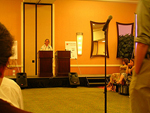
Ubicomp 2006
Bruce Sterling and Brenda Laurel gave the opening and closing keynote speeches at Ubicomp 2006. It made for an interesting comparison as they both spoke about magic but took absolutely opposite positions. Bruce Sterling claimed that magic does not exist, that believing in magic (by which I understood him to mean superstition, religion and animism) might make us feel better but does nothing to help us understand and develop our culture and environment. On the other hand, Brenda Laurel embraced animism and encouraged wonderment at the world around us to inspire and inform design of technologies. For her, magic is natural magic, the patterns, forms and processes of nature that we barely understand yet which drive our world. She urged designers to design for pleasure and spoke of the fairies in her garden, the wind fairy who would whisper to her when there was wind on the way and the lavendar fairy who would tell the bee fairy when the lavendar was flowering. These technological fairies are, of course, examples of animism which Bruce Sterling disapproved of so strongly.
In 2005 I worked as a research assistant to Stephen Gage who was writing a paper exploring the relationship between interactive architecture and magic. He now uses these principles in his teaching at the Bartlett. In the course of this he drew out three different types of magic, superstitious magic, natural magic and stage managed magic or the suspension of disbelief. This third form of magic is inherent in most designed, interactive experiences - including Brenda Laurel’s technological fairies. Most interactive systems create an illusion - commonly called an interface - which is presented to the people using or experiencing the object or situation. The role of this interface is to hide away the processes that are going on behind-the-scenes so that the participant is more easily able to fulfil their role in the playing out of the experience. This paper by Bruce Tognazzini has a good description of this.
You could say that in creating this illusion designers are trying to fool the participants, to dumb-down and simplify the technology, to put it in a black box and cover it with a smiley face (or a skull and crossbones, the emotion is irrelevent. I am talking about intention here) or, you can see the interface as being only the first step in a process of engagement with the technology. In this case the system should be open-ended enough for the participant’s engagement to deepen over time as the underlying technology and processes are exposed little bit by little bit.
The Processing language is a good example of this. It has an easy-to-use interface and simple commands that can be built into reasonably complex scripts making it very accessible to novice programmers. But it also lets programmers integrate Java code into their scripts alongside the Processing code. This means you do not have to move all at once to the complexities of Java programming, instead the process is driven by your programming skill and needs. Of course, the illusion of what is happening behind the scenes is never completely revealed but some insight into how it is constructed is there if you choose to look.
From:Mr. Watson In 2005 I worked as a research assistant to Stephen Gage who was writing a paper exploring the relationship between interactive architecture and magic. He now uses these principles in his teaching at the Bartlett. In the course of this he drew out three different types of magic, superstitious magic, natural magic and stage managed magic or the suspension of disbelief. This third form of magic is inherent in most designed, interactive experiences - including Brenda Laurel’s technological fairies. Most interactive systems create an illusion - commonly called an interface - which is presented to the people using or experiencing the object or situation. The role of this interface is to hide away the processes that are going on behind-the-scenes so that the participant is more easily able to fulfil their role in the playing out of the experience. This paper by Bruce Tognazzini has a good description of this.
You could say that in creating this illusion designers are trying to fool the participants, to dumb-down and simplify the technology, to put it in a black box and cover it with a smiley face (or a skull and crossbones, the emotion is irrelevent. I am talking about intention here) or, you can see the interface as being only the first step in a process of engagement with the technology. In this case the system should be open-ended enough for the participant’s engagement to deepen over time as the underlying technology and processes are exposed little bit by little bit.
The Processing language is a good example of this. It has an easy-to-use interface and simple commands that can be built into reasonably complex scripts making it very accessible to novice programmers. But it also lets programmers integrate Java code into their scripts alongside the Processing code. This means you do not have to move all at once to the complexities of Java programming, instead the process is driven by your programming skill and needs. Of course, the illusion of what is happening behind the scenes is never completely revealed but some insight into how it is constructed is there if you choose to look.
From: Mr. Watson, September 24, 2006. http://www.prusikloop.org/mrwatson/?m=200609n See also: http://www.prusikloop.org/mrwatson/?m=200609 for more on architecture and magic
Posted by newradio at 09:51 AM | Comments (0)
September 14, 2006
[iDC] Architecture and Situated Technologies - September Overture
![]()
Anne Galloway
Thanks Mark for your thoughtful introduction to the September discussions. I've been following with great interest since I introduced myself in July, and now I'd like to share and begin to explore some things that have particularly resonated with me.
You mention the "current status of the material object [and] forms of embodied interaction" and I've often thought about this 'return' to the body and the physical after the (failed?) promises of cyberspace disembodiment. In other words, I see a kind of re-embodiment ethos at work right now in research, art and design practice, and a re-newed commitment to the material. In some ways, then, it seems that the pendulum of technological desire has merely swung to the other side.
Since my first two degrees are in anthropology and archaeology I also have a special interest in material culture. Coupled with my doctoral work in social studies of science and technology, I find this question of materiality to be rather persistent in my research. If you'll forgive my self-referencing, Matt Ward and I wrote a paper recently about some intersections we saw between archaeology and locative media design:
http://leoalmanac.org/journal/Vol_14/lea_v14_n03-04/gallowayward.asp
and I continue to imagine a possible future where complex legal battles are being fought over the cultural repatriation of digital artefacts
I mean, I sometimes wonder if our pervasive computing collections (we _are_ still talking databases) will more closely resemble the British Museum (http://www.thebritishmuseum.ac.uk/) or the City Reliquary (http://www.cityreliquary.org/)?
I also wonder about a current fetishising of 'things'. Or how can we 'return to the object' without privileging objectivity? I really disliked the phrase 'the internet of things' when I first heard it, but I've since embraced it as a rather lovely manifestation of a type of contemporary commodity fetishism. Earlier this year I gathered links on the historical development and use of the phrase, and it's not difficult to trace its movements--its inscription devices--from academic-industry research partnerships to popular business and technology publications to popular blogs and back to academic-industry research partnerships.
http://www.purselipsquarejaw.org/2006/03/internet-of-things-working.php
http://www.purselipsquarejaw.org/2006/09/bibliography-of-things.php
You may note in that cycle I just described there was no mention of particular technologies, or rather no mention of pervasive computing devices. I think that the material status of 'pervasive computing' today can be profitably distinguished from the material dreams of 'the internet of things'. (The _things_ we're talking about are different in each case.) In actuality, most embedded computing today is used for surveillance/monitoring or 'consumer convenience' and _not_ for participatory media production. I guess my point is that pervasive computing in its most banal and mundane expressions is by definition dull and boring. It's the Oyster card used on the Tube every day, the fingerprint scan to get into the office, the rfid tag stuck on the broom. But that's also _everyday life_ and sometimes boredom is just what people want and need. Plus, I try to never underestimate how inventive people are when it comes to finding hope and joy in small things.
I think that David Lyon got it right when he described surveillance as 'social sorting,' even if his sense of the social was too humanist for my taste. The sorts of structured and stored monitoring necessary for context-aware computing are also matters of spatial and cultural sorting (inclusion and exclusion). I find that we're still not very clear on these notions of 'publics' or 'communities' either, or rather that people are working with a multitude of different understandings that are often glossed over in conversation. Add to this the matter of matter--or things--and we're in a downright voluptuous state, where _things_ often don't co-operate.
So we induce, we create, places where it's easy to associate only with those who share our interests and values, where it's easy to avoid being accountable to, and for, precisely those interests and values that we do not share. And all despite the fact that we pass different others--move through spaces together--every day! (I guess that does trouble me.) At the same time, I'm not sure it's productive to essentially reframe this social and cultural discussion in terms of public and private. I'm not sure that dichotomy is either reliable or useful beyond helping me understand the everyday movements in-between...
In any case, I do continue to focus my work on how we are (re?)imagining our being-together in mobility--and I'm looking forward to our continuing discussions and to meeting some of you at the symposium.
Kind regards,
Anne
--
Anne Galloway
Dept. of Sociology & Anthropology
7th Floor, Loeb Building
Carleton University
1125 Colonel By Drive
Ottawa, Ontario
Canada K1S 5B6
www.purselipsquarejaw.org
www.spaceandculture.org
From Mark Shepard, September 20, 2006:
Anne wrote:
> I also wonder about a current fetishising of 'things'. Or how can
> we 'return to the object' without privileging objectivity?
I think this is a key question. As Sterling noted at the talk he gave for the Lift conference[1] last March, the phrase "Internet of Things" is a useful one if you are looking for venture capital in southern California. And indeed, the discourse surrounding the convergence of ubiquitous / embedded / context-aware / geospatial / locative technologies finds its (fundable) applications predominately in the commodity object or "objective" control systems for the military- industrial-light-and-magic complex. So it's not surprising that given the circuit running from "academic-industry research partnerships to popular business and technology publications to popular blogs and back to academic-industry research partnerships" produces ideas that feed this fetish for the object and objectivity.
Trebor asks:
> So, why talk of "things" instead of objects?
Well, for one thing, calling them objects doesn't account for meanings such as "That's another thing entirely", "She knows how to handle things", or "We're just doing our thing." Things are "actions, events and affairs" as much as they are "artifacts." Networked _things_ are not at all the same as networked objects (but they may include them). When we reduce _things_ to objects, however, we limit our ability to consider how _things_ are embedded within everyday life, their meaning contingent upon their use (or mis-use), and the relations they enact or perform.
Take Heidegger's "jug", for example:
> "No representation of what is present, in the sense of what stands
> forth and of what stands over against as an object, ever reaches to
> the thing qua thing. The jug's thingness resides in its being a qua
> vessel. We become aware of the vessel's holding nature when we fill
> the jug... the pouring that fills it flows into the empty jug. The
> empty space, this nothing of the jug, is what the jug is as the
> holding vessel... But if the holding is done by the jug's void,
> then the potter who forms sides and bottom on his wheel does not,
> strictly speaking, make the jug... The vessel's thingness does not
> lie at all in the material of which it consists, but in the void
> that holds." [2]
Heidegger's understanding of the thing stands in contradistinction to the object. While I find the larger argument he's making in this essay problematic, I do find useful the idea that the "thingness" of the thing doesn't reside in its being a representable object, but rather in the way _things_ bring human practices together and make them intelligible.
Recently I screened Tati's "Play Time" for a group of graduate students. I am always fasinated by the way _things_ for Tati - modernist chairs, glass plane doors (or at least their handles) - carry with them an excess beyond their role as functional objects. With the chairs, for example, that excess is the sound they produce when sitting on them, how the body engages with the acoustic properties of the material, and the (hilarious) social implications of this... This excess often lies in the difference between how things are designed and how they are used, or how they perform in ways not anticipated by their designers.
Dunne and Raby's "post-optimal" electronic objects would appear to take this excess as an opportunity for a reflexive, critical design practice, one that doesn't so much reject the optimizations and efficiencies of Taylorism as it considers them moot: already achieved, and therefore not much of a design challenge. If anything, contrary to Trebor's suggestion, I'd say critical design can play a key role in shaping a future of things that are not invested in "intentionally restricting the way the user can behave, or enforce certain modes of behavior."
Ulises wrote:
> I fear that our technophilia is obscuring the politics of these
> virtual-actual assemblages, obstructing the need to critically
> assess how agency is distributed amongst things connected through
> the internet.
The question of agency here is crucial. But I think it's useful to distinguish between humans and things in actor networks. This might help abate some of the hysteria surrounding the current discussion. That we can see networked things as systems doesn't necessarily mean that these systems can think, act, or exercise power in any subjective way.
Still, subjective human agency is but one form of "being in action or exerting power", and its important to consider how representative democracies, for example, can be influenced by _things_ that are capable of asserting themselves within networked societies.
Take Bruno Latour's Parliament of Things, for example:
> Let one of the representatives talk, for instance, about the ozone
> hole, another represent the Monsanto chemical industry, a third the
> workers of the same chemical industry, another the voters of New
> Hampshire, a fifth the meteorology of the polar regions; let still
> another speak in the name of the State; what does it matter, so
> long as they are all talking about the same thing, about a quasi-
> object they have all created, the object-discourse-nature-society
> whose new properties astound us all and whose network extends from
> my refrigerator to the Antarctic by way of chemistry, law, the
> State, the economy and satellites. [3]
Or Julian Bleecker's description of Blogject agency:
> Agency as I am using it here does not just mean a local “artificial
> intelligence” that makes a Blogject able to make autonomous, human-
> like decision or fashion croaky human-speech from text. Blogjects
> have no truck with the syntax of human thought. Things could not
> care any less about their Turing Test report card. Blogject
> intellect is their ability to effect change. Their agency attains
> through the consequence of their assertions, and through the
> significant perspective they deliver to meaningful conversations.
> Blogjects bring something heavy to the table. Or, they are brought
> to the table because they have semantic weight. Agency is
> literally imbued in Blogjects. Things that matter completely sully
> the previously starched white relationship between subject and
> object, human and nonhuman. Things that matter inflect the course
> of social debate and discussion, and cannot help inflicting local
> and global change. Witness the Spotted Owl. Witness the Pacific
> Northwest Salmon. Witness all the non-human, non-subject "things"
> that became fully imbued with the status of first-class citizens.
> Heck, most humans don't have the capacity to effect the kind of
> worldly change and receive the same order of protection, status and
> economic resources as a fish.
These networked things are obviously far more than "just pieces of metal and silicon... " and at the same time far less than the hype and hysteria currently surrounding them might suggest.
Best,
Mark
+++
[1] http://video.google.com/videoplay?docid=-8575858411965484751&q=bruce+sterling&hl=en
[2] Heidegger, "The Thing," in Poetry, Language, Thought, A. Hofstadter, trans. (New York: Harper & Row, 1971)
[3] Latour, Bruno. We Have Never Been Modern, trans. by C. Porter. Cambridge, MA: Harvard University Press. 1993. p. 144
[4] Bleecker, Julian. Why Things Matter. 2006. http://research.techkwondo.com/files/WhyThingsMatter.pdf
+
mark shepard
+
http://www.andinc.org
iDC -- mailing list of the Institute for Distributed Creativity:: iDC[at]bbs.thing.net :: http://mailman.thing.net/cgi-bin/mailman/listinfo/idc
List Archive: http://mailman.thing.net/pipermail/idc/
Posted by jo at 04:17 PM | Comments (0)
September 13, 2006
Living in a World of Smart Everyday Objects
Risk Evaluation of Pervasive Computing
A quote from Jürgen Bohn, Vlad Coroama, Marc Langheinrich, Friedemann Mattern, Michael Rohs Living in a World of Smart Everyday Objects – Social, Economic, and Ethical Implications. Journal of Human and Ecological Risk Assessment, Vol. 10, No. 5, pp. 763-786, October 2004.
Today’s technical infrastructures, such as the phone system, television, and electricity, are relatively easy to use, even for people with no special qualifications. This also entails the ability to detect malfunctions: for example, if you lift a telephone receiver and do not hear a dial tone, it is immediately evident that the phone (either the handset or the landline) is not working properly. However, this type of predictability of system behavior can no longer be taken for granted in an ambient-intelligence landscape, as systems are expected to function without users noticing their presence. This will make fault detection and diagnosis fundamentally difficult, especially for the layman (Estrin et al. 2002). Additionally, users might continue to rely on a failed service (e.g., an automated backup service or the self-diagnostics of a smart product) without noticing, thus increasing the damage done until the problem is finally discovered. [blogged by nicolas on pasta and vinegar]
Posted by jo at 08:12 AM | Comments (0)
August 16, 2006
Data bodies

Re-Gaining a Sense of Privacy in Public Space
The Super Vision performance (via Grand Text Auto), by the Builders Association and dbox, was presented last week at ISEA and it looks taps right into my interests of the moment (which are roughly about artists/hackers' guerilla tactics to re-gain a sense of privacy in public space.)
Even before we are born, our personal electronic data begins to accumulate and to circulate. From our first sonogram, to birth certificates, academic records, dental records, credit card purchases, passports, and emails – as we grow, our “data body” grows with us, and becomes an integral part of our identity. In the age of information, we have come to accept, allow, and depend upon this new identity. How do we relate to the growing cloud of data that surrounds us and others?
Super Vision explores the changing nature of our relationship to living in a post-private society where personal electronic information is constantly collected and distributed. These bodies exist in a “data space” which remains mostly invisible. Super Vision makes that space visible.
SUPER VISION tells three stories:
1. As he crosses borders, a traveler gradually is forced to reveal all of his personal information, until his identity becomes transparent, with no part of his life left outside the bounds of dataveillance.
2. As a woman tries to digitally archive her Grandmother’s past, the grandmother slips into senility. The woman is left to discover what remains of her Grandmother’s life – and her own – outside the realm of data.
3. A father covertly exploits his young son’s personal data to meet the demands of the family’s lifestyle. This ploy escalates beyond control, until he is compelled to disappear. His wife and son are left with a starkly diminished data portrait, and his escape is shadowed by the long reach of the datasphere.
The artists will perform again on Thu–Sat, Aug 17–19 at the Yerba Buena, San Francisco.
Reading about this work made me think about a couple of projects that i'll introduce with a quote from Futurologist Ian Pearson: "[In the future] there will be chips all over the high street relaying information and you will be bombarded with digital information everywhere you go," said Pearson. "You will need a digital bubble force field — a shield that lets through what you want and blocks everything else." (via)

First project is the floatable jellyfish-like vessels, by Usman Haque. The vessels would drift around cities to create ephemeral zones of truly private space: an absence of phone calls, emails, access of GPS devices, TV broadcasts, wireless networks and other microwave emissions. They can also provide shielding from the gaze surveillance systems.

A second project is Freezone. British artist Stanza imagined that information free zones could become the holiday destination of the future. All mobile phones, passports, id cards or chips would be left outside the pod.
Katherine Moriwaki has also explored the data that follows us like a shadow with Recoil. Powerful magnets sewed into suits allow the wearer creates a data-free zone, by erasing the data contained in memory devices like credit cards.

These garments can also serve to heighten awareness in the wearer and others as to the high penetration of digital technologies into our everyday lives and reasserts awareness of bodily presence in the environment.
Last work that sprung to my mind was Chris Oakley's video The Catalogue which envisions humanity as a series of trackable units whose value is defined by their spending capacity and future needs. [blogged by Régine on we-make-money-not-art]
Posted by jo at 07:11 PM | Comments (0)
June 22, 2006
Networked Place Book

Call for Comments
"As a culmination to the Networked Publics program, we are publishing a collaboratively written group book with the MIT Press. As part of this process, we are soliciting reader comments for inclusion in the book. Below is a draft of the essay on Networked Place (note that there is a word document attached too... it is likely easier to read). We intend to take the comments that we received and append them to the essay in a virtual symposium that will follow each chapter. In doing so, we hope to create a more dialogic forum within the book. Please leave your email addresses so that we can get in touch with you about your contribution.
Introduction: Contemporary life is dominated by the pervasiveness of the network. With the spread of the mobile phone worldwide (arguably history’s most successful gadget) and the growth of always-on broadband in the developed world, technological networks are becoming easier to access and more ubiquitous. The “always-on,” “always-accessible,” network—or at least the promise of that condition—has produced a broad set of changes to our concept of place, linking space to network to create networked place.
"The following essay addresses both the networking of space and the spatiality of the network. We identify a series of conditions symptomatic of the culture of network “space”: the everyday superimposition of simultaneous real and virtual spaces, the development of a mobile sense of place or “telecocoon,” the emergence of real virtual worlds, the rise of the network as a socio-spatial model, and the use of mapping technology as a means of understanding the world. At the same time, we recognize that these changes are not simply produced by technology. On the contrary, the development and practices of technology (and the conceptual shifts that these new technological practices produce) are thoroughly imbricated in culture, society, and politics.
Taken together, these changes are already radical, but they may not be radical enough. These could well be the first steps in restructuring our concept of spatiality. The changes we listed above—and describe below—may be mere evidence of the early days of sociocultural shifts of which we can only be partially aware, just as the first theorists of modernism and postmodernism could only partially understand the emerging condition of their day." Continue reading Networked Place by Kazys Varnelis and Anne Friedberg, Networked Publics.
Posted by jo at 05:41 PM | Comments (0)
May 24, 2006
Bruce Sterling

The Future of Media Arts
Ally #1, Bruce Sterling, has laid down another phenomenal rant, this time on the future of media arts. It's a lovely stroll through ubiquitous computing, how the Internet of things maps to the 3D world, and why the art world has a critical role to play in understanding how this new blending of smart places, spimes, and systems for making visible the invisible come together, an exploration of what art becomes when the actual is the new virtual. If you have no idea what we mean when we use these phrases, it's even more worth your time.
You can listen to the entire talk here. [blogged by Alex Steffen on World Changing]
Posted by jo at 05:44 PM | Comments (0)
DIGITAL TERRITORY: BUBBLES
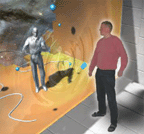
The Domestication of the Ambient Intelligence Space
"[...] By defining digital borders, the vision of digital territory creates a continuum between the physical world and its digitised counterpart. The construction of digital boundaries consolidates the gateways already established between these two worlds. This paradox will be catalysed by the implementation of a growing number of bridges between the two environments. Location-based services, radio frequency identification tags, body implants, ambient intelligence sensors, etc. will permit the implementation of a trustworthy environment and therefore the domestication of the ambient intelligence space by the individual. The vision will facilitate the transition through a traditional society that coexists with an information society, to a single society whose citizens have accepted and adopted the fusion of physical and digital realities. In this future society, people will still be able to control and manage distance from others with new tools provided by ambient intelligence space technologies." From DIGITAL TERRITORY: BUBBLES by Laurent Beslay and Hannu Hakala.
Posted by jo at 11:03 AM | Comments (0)
May 22, 2006
Winning (and Losing) the First Wired War
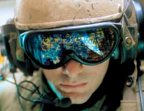
Network Hierarchies + the Connectivity Gap
defensetech.org writes on a digital divide, of sorts, that has put a strangle-hold on the theory that with communication, command and control tethered via digital networks, the armed forces of America would be more effective at conquering soverign states. Such is turning out not to be entirely the case. Most of the command units are able to make use of these networks, but evidently their effectivity plummets because units taking care of firing and dodging bullets and IEDs are off the grid, largely. And yesterday I heard a news story about two armored fighting units that could not communicate with each other — despite the fact that they were only a few meters away. Why? Incompatible communications gear. The radios were literally incompatible. Boggling, but maybe not so much considering the proprietary nature of so much of the gear.
To the US Forces pre-breakup AT&T, the insurgency is playing John Draper aka Cap'n Crunch.
Winning (and Losing) the First Wired War:
This war in Iraq was launched on a theory: That, with the right communication and reconnaissance gear, American armed forces would be quicksilver-fast and supremely lethal. A country could be conquered with only a fraction of the soldiers needed in the past.
During the initial invasion in March 2003, this idea of "network-centric warfare" worked more or less as promised -- even though most of the frontline troops weren't wired up. It was enough that the commanders were connected.
But now, more than three years into the Iraq conflict, the network is still largely incomplete. Local command centers have a torrent of information pouring in. But, for soldiers and marines on the ground, this war isn't any more wired that the last one. "There is a connectivity gap," a draft Army War College report notes. "Information is not reaching the lowest levels."
And the insurgency has taken on a hacker sensibility:
And that's a problem, because the insurgents are stitching together their own communications network. Using throwaway cellphones and anonymous e-mail accounts, these guerrillas rely on a loose web of connections, not a top-down command structure. And they don't fight in large groups that can be easily tracked by high-tech command posts. They have to be hunted down in dark neighborhoods, found amid thousands of civilians, and taken out one by one.
Why do I blog this? Institutions like the military, while barely prone to the social practice adoptions that one finds in democratic formations, in many ways test some of the directions that open society social practices can go under particular situations. Could this be an indicator of how net neutrality plays out if networks get all gummmed up with non-open standards and proprietary protocols? [blogged by Julian Bleecker on techkwondo]
Posted by jo at 11:29 AM | Comments (0)
March 09, 2006
Wi-fi Set to Re-Wire Social Rules

The Divide that Separates People from their Online Lives
This BBC article quotes Dr. Jo Twist, a senior research fellow at the Institute for Public Policy Research in the UK, as saying
"once the net was ubiquitous like power and water, it had the potential to be "transformative". The divide that separates people from their online lives will utterly disappear. Instead of leaving behind all those net-based friends and activities when you walk out of your front door, you will be able to take them with you.The buddies you have on instant message networks, friends and family on e-mail, your eBay auctions, your avatars in online games, the TV shows you have stored on disk, your digital pictures, your blog - everything will be just a click away. It could also kick off entirely new ways of living, working and playing. For instance, restaurant reviews could be geographically tagged so as soon as you approach a cafe or coffee shop, the views of recent diners could scroll up on your handheld gadget. Alternative reality games could also become popular. These use actors in real world locations to play out the ultimate interactive experience. Key to the transformation, said Dr. Twist, would be mobile devices that can use wi-fi. These handsets are only just starting to appear but will likely cram a huge amount of functions into one gadget. Dr. Twist believes the move could start to close the digital divide". Further, "when chips, sensors, and wireless devices mesh together, there may be some unintended consequences," said Dr. Twist. "We have to make sure we think about those, and think about what other exclusions might be brought about by those developments, too." [posted by Jim Downing on Smart Mobs]
Posted by jo at 12:45 PM | Comments (0)
March 01, 2006
An electronic ghetto within the emerging information city
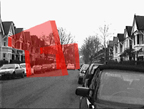
Data and Media Black Holes
Today reading in the train: Beyond Blade runner: Urban control, the ecology of fear by Mike Davis. An excerpt I liked:
Perhaps, as William Gibson suggests, 3-dimensional computer interfaces will soon allow post-modern flaneurs (or ‘console cowboys’) to stroll through the luminous geometry of this mnemonic city where data-bases have become ‘blue pyramids’ and ‘cold spiral arms’.
If so, urban cyberspace - as the simulation of the city’s information order - will be experienced as even more segregated, and devoid of true public space, than the traditional built city. Southcentral LA, for instance, is a data and media black hole, without local cable programming or links to major data systems. Just as it became a housing/jobs ghetto in the early twentieth century industrial city, it is now evolving into an electronic ghetto within the emerging information city.
Why do I blog this? what I like there is (1) this idea of embedding virtual data flows in reality (through light/displays, as in this project or this one for example), (2) the notion of electronic divide: there’s going to be ghettos without data holes.
This is connected to Usman Haque’s paper about Invisible Topographies quoting Antony Dunne:
Humans have only recently begun contributing to the cacophony with their pagers, medical devices, television broadcasts and mobile phones. This abundant invisible territory, a topography that is altered in shape and intensity by both natural and human-constructed landscapes, has been called “hertzian space” by industrial design theorist Anthony Dunne. He has observed that hertzian space is often ignored by designers saying, in Hertzian Tales, that the “material responses to immaterial electromagnetic fields can lead to new aesthetic possibilities for architecture."
[The image above is] an example of such idea (I can’t find the source of this, can you help me? author(s)? project?). [blogged by nicolas on pasta and vinegar]
Posted by jo at 08:18 AM | Comments (0)
February 08, 2006
First Monday, Special Issue #4:
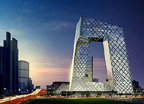
Urban Screens
Urban Screens: Discovering the Potential of Outdoor Screens for Urban Society, Pieter Boeder, Geert Lovink, Sabine Niederer, and Mirjam Struppek, eds. Table of Contents: Introduction: Discovering the potential of outdoor screens for urban society by Pieter Boeder and Mirjam Struppek; Urban screens: The beginning of a universal visual culture by Paul Martin Lester; The politics of public space in the media city by Scott McQuire; The poetics of urban media surfaces by Lev Manovich; Interpreting urban screens; by Anthony Auerbach; Story space: A theoretical grounding for the new urban annotation by Rekha Murthy; The urban incubator: (De)constructive (re)presentation of heterotopian spatiality and virtual image(ries) by Wael Salah Fahmi; Urban screens: Towards the convergence of architecture and audiovisual media by Tore Slaatta; Towards an integrated architectural media space by Ava Fatah gen. Schieck; Art and social displays in the branding of the city: Token screens or opportunities for difference? by Julia Nevárez; Hijacking the urban screen: Trends in outdoor advertising and predictions for the use of video art and urban screens by Raina Kumra; For an aesthetics of transmission by Giselle Beiguelman; Intelligent skin: Real virtual by Vera Bühlmann; Programming video art for urban screens in public space by Kate Taylor; Augmenting the City with Urban Screens by Florian Resatsch, Daniel Michelis, Corina Weber, and Thomas Schildhauer.
Introduction
Welcome, gentle reader, to this First Monday Urban Screens special issue, the first publication of its kind. With the advent of digital media, the global communication environment has changed dramatically. In the context of the rapidly evolving commercial information sphere of our cities, especially since the 1990s, a number of novel digital display technologies have been introduced into the urban landscape. This transformation has intersected with other major transformations of media technology and culture over the last two decades: the formation of distributed global networks and the emergence of mobile media platforms such as mobile phones. Their cumulative and synergistic impact has been profound. Convergence of screen technologies with digital communication technologies such as GSM, RFID, Internet and database technologies has lead to the emergence of a new, interactive and increasingly pervasive medium: Urban Screens.
Urban Screens can be defined as interactive, dynamic digital information displays in urban environments. Their genesis is the consequence of two parallel technological developments: evolution and subsequent growth in magnitude of the traditional display screen, and its subsequent convergence with other digital media technologies. Forms and appearances range from large daylight compatible LED billboards, plasma or SED screens, information displays in public transportation systems and electronic city information terminals to dynamic, intelligent surfaces that may be fully integrated into architectural façade structures. Their introduction in the urban environment poses new, unparalleled challenges and opportunities, which we will explore
and document in this issue.
Currently, the primary purpose of this new infrastructure appears to be the management and control of consumer behaviour through advertising. Commercial companies are starting to realise that digital billboards are a powerful medium to communicate their goals and missions, in line with the new paradigms of the digital economy. Interconnected Urban Screens have tremendous potential to serve as a platform for information exchange. Such large networks are already being developed Russia, China, USA and South America, where Urban Screens are rapidly becoming a key element in commercial and government informational infrastructure. The implications for the public sphere are profound. Information density per square metre is increasing, yet at the same time individuals have less control than ever over the actual format and content of that information.
Public space has always been a place for human interaction, a unique arena for the exchange of rituals and communication. Its architecture, being a storytelling medium itself, plays an important role in providing a stage for this interaction. The ways in which public space is inhabited can be read as a participatory process of its audience. Its (vanishing) role as a space for social and symbolic discourse has often been discussed in urban sociology. Modernisation, the growing independence of place and time and individualisation seem to devastate traditional city life and its social rhythm. The Urban Screens project explores the opportunities for opening this steadily growing infrastructure of digital screens, currently dominated by market forces, for cultural content, along with its potential for revitalising of the public sphere.
Urban Screens 2005 was the first international conference that was solely dedicated to the emerging Urban Screens phenomenon. Presentations covered a broad spectrum of topics and issues, ranging from critical theory to project experiences by researchers and practitioners in the field of art, architecture, urban studies and digital culture. It addressed the growing infrastructure of large digital moving displays, which increasingly influence and structure the visual sphere of our public spaces. Urban Screens 2005 investigated how the currently dominating commercial use of these screens can be broadened and culturally curated: can these screens become a tool to contribute to a lively urban society, involving its audience interactively?
A new medium that is digital, interactive and pervasive
What we are seeing is the emergence of a new medium that is digital, global and local, interactive and pervasive at the same time. What happens if the convergence of new technologies such as Internet, database and mobile technologies suddenly enable interactive access to the visual streaming of these digital surfaces? Can it revitalise the public sphere by creating an information-dense urban environment or is it a major threat? How does the growing infrastructure of digital displays influence the perception of the visual sphere of our public spaces? Metaphorically speaking, can or do Urban Screens already function as a mirror, reflecting the public sphere?
The Urban Screens project aims to address these questions in a transdisciplinary debate and present new approaches to answering the most pushing urgent questions, exchange experiences and create and maintain a thematical network around the subject for initiating future collaborations. The Urban Screens 2005 conference in Amsterdam addressed the existing commercial predetermination and explored the nuance between art, interventions and entertainment to stimulate a lively culture. Other key issues were mediated interaction, content, participation of the local community, possible restrictions due to technical limits, and the incorporation of screens in the architecture of our urban landscape.
Urban Screens 2006: Demonstrating the potential of public screens for interaction
Building upon the results of Urban Screens 2005, the 2006 Urban Screens 2006 conference (Berlin, October 5-6) will elaborate on the discussion and develop the broad spectrum of possible formats and usage of this emerging new media infrastructure. Urban Screens 2006 will be a platform for demonstrating the potential of public screens for interaction in a trinity of infrastructure, content and cooperation models. Interconnected topics will be the politics of public space, multimedia content as a service for an array of portable devices, urban neighbourhood reactivation, interaction design of urban screens, standardisation and integration in the urban landscape. Using existing screens infrastructure as well as future 'Urban Screens furniture' in the urban space of Berlin, we will demonstrate the impact of Urban Screens, their contextualisation and situatedness. This unique accumulation of projects will serve as a playground and research field for practical observations on the interplay of screen technology, content, location and format.
Urban Screens 2007: Expanding the potential of content for community
screens
Urban Screens 2007 is currently under preparation in collaboration with BBC Public Space Broadcasting. While Urban Screens 2006 will have 'brick & mortar' accents, Urban Screens 2007 will have a distinct focus on the potential of journalistic content: issues surrounding the production and display of media content for Urban Screens, as well as adaptive reuse of 'old' content for new media will be explored in detail. Key issues and topics will include Public Space Broadcasting (PSB), the politics of public space, mediated interaction and participation, as well as experiments with new participatory formats. PSB can energise the hearts of cities by bringing together communities to share events and broadcasts, creating public news and information points that double as local meeting places. Largely due to the innovative work of the BBC, PSB is starting to prove its potential to provide an outlet for community and educational activities, public service information, visual arts, digital innovation and local content production, revitalising the public sphere.
We hope that you will share our excitement.
Posted by jo at 09:09 AM | Comments (0)
February 06, 2006
From Interaction to Participation:
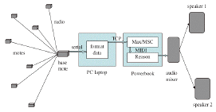
Configuring Space through Embodied Interaction
"Abstract: When computation moves off the desktop, how will it transform the new spaces that it comes to occupy? How will people encounter and understand these spaces, and how will they interact with each other through the augmented capabilities of such spaces? We have been exploring these questions through a prototype system in which augmented objects are used to control a complex audio 'soundscape.' The system involves a range of objects distributed through a space, supporting simultaneous use by many participants. We have deployed this system at a number of settings in which groups of people have explored it collaboratively. Our initial explorations of the use of this system reveal a number of important considerations for how we design for the interrelationships between people, objects, and spaces." From From Interaction to Participation: Configuring Space through Embodied Interaction by Amanda Williams, Eric Kabisch, and Paul Dourish.
"This paper addresses this very important question: how will ubiquitous computing transform the new spaces that it comes to occupy; or what sorts of impacts on space result when it is populated by ubicomp technologies? The paper starts by describing how space and social action are tightly entwined. Then they examine the development and evaluation of a collective dynamic audio installation called SignalPlay (a series of physical objects with embedded computational properties collectively control a dynamic “sound-scape” which responds to the orientation, configuration, and movement of the component objects).
Some excerpts of this insightful paper:
Our fundamental concern is with the ways in which we encounter space not simply as a container for our actions, but as a setting within which we act. The embodied nature of activity is an issue for a range of technologies.
(…)
This social character means that spaces are not “given”; they are the products of active processes of interpretation. The meaningfulness of space is a consequence of our encounters with it. For ubiquitous computing, this is an important consideration. (…) The research challenge, then, is to understand how it is that computationally augmented spaces will be legible; with how people will be able to understand them and act within them..." [blogged by nicolas on pasta and vinegar]
Posted by jo at 02:49 PM | Comments (0)
Patrick Lichty
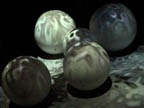
Building a Culture of Ubiquity
"...In my body of research vis-à-vis the shift in praxis from the screen to the palm to the body to the space, there are issues of representation that are revealed through the way that aesthetic content is embodied through the interface. This interface may be a screen, dataglove, head-mounted display or responsive space, but each mode of representation illustrated by each display or input device indicates a unique space of interaction and expression, whether on the screen body, or reinscribed in space itself. As we consider the arc of praxis from screen to body to space, perhaps this may create some insight into how a culture of technological ubiquity will be constructed, and what modes of expression may emerge from such cultural forms and technological developments...
...The catalyzing forces behind this cultural shift are connectivity between individuals and decentralized distribution of communication and content. These factors underlie the creation of the electronic culture, and are essential to the work described here. But, as this portion of humanity moves towards a culture of ubiquity, there are a series of localities that may serve as points of analysis for the communications of cultural codes. Each (the screen, palm/pocket, body, and public space) has unique modes of representation that allude to Hayles' linkage of the subject between its signification and the embodiment of experience [6]. All of these localities make visible systems of production, consumption, and representation that illustrate a possible ecology of signs within a culture of ubiquity." From Building a Culture of Ubiquity by Patrick Lichty
Posted by jo at 12:24 PM | Comments (0)
January 27, 2006
Anne Galloway
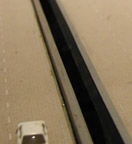
Against Disambiguation
In Disambiguating the terminology (a sketch), Mike writes:
'As I see it, the different terms--pervasive computing, ubiquitous computing, ambient intelligence and physical computing--come from different historical contexts that are based on geography: PARC coined "ubiquitous computing," so it's big on the West Coast; IBM likes "pervasive," they get the East; Philips was responsible for "ambient intelligence," so that's what it's called in Europe. In reality, it's just a blind men and elephant problem. They're all describing the same idea, but alliances and territoriality create clusters of terminology...The definitions aren't totally separate, but it's an interesting exercise to see the focus of the groups who fly a particular flag. I still think it's all the same elephant and that maybe it needs an even yet different term. There's great value in creating a good term that encapsulates a set of ideas, but it has to accurately capture the essense of an idea as it is perceived by others to take off. Which means it needs to be externally-focused, and not about the process.'
And in the comments:
AG: Why do you think I felt it necessary to create a whole new term for these activities, even at the risk of collapsing valid distinctions?...[I] argue that even things that seem peripheral to the ubicomp argument...will in fact be for most of the people experiencing it the signifiers of the ubiquitous experience.
Mike: If people's associations with it are going to be with the objects, not the ideas, I believe that names for the idea should reflect THEIR perspective.
The elephant analogy doesn't sit well with me if it implies that there is, in fact, a stable thing-in-the-world that constitutes an elephant (and that the men are wrong because they don't know they're describing the same thing). As I understand it, the parable's moral is rather about not clinging too hard to any particular perspective because there are many truths. And I take that to suggest not only that inflexibility is problematic, but that disambiguation is as well - precisely because of "the risk of collapsing valid distinctions" and becoming too invested in getting the 'one ring to rule them all'.
The erasure of difference is never neutral, and this desire to master a subject, to bring it to order and unity, to suggest its discovery and conquest through neologism, is at the heart of what feminist studies of science and technology have long criticised as exclusionary practices rife with power struggles. This belief in necessary wholeness is also associated with a concern for the "effects" of technology, and can reflect the kind of technological determinism present in the "guns don't kill people, people kill people" way of thinking and its ethical implications.
Plus, can any term "accurately capture the essense of an idea as it is perceived by others"? What's the purpose of that anyway? Why not let it be all messy? Leaving aside my opposition to essentialism and the idea that there are discrete things in the world, I was struck by Mike's claims regarding who should decide a new terminology. Anthropologists have spent many years debating the merits of emic (intrinsic cultural distinctions) versus etic (imposed by the anthropologist or outsider) classifications*. After all, what would make one better or worse than the other? And why would we choose to use just one? Furthermore, when Mike suggests that it is others-outside-the-process who should be naming things, he naturalises distinctions between "us" (designers, presumably) and "them" (users, people), as well as between design and use, process and product. Ultimately, this elides internal variation within each category, over-emphasises external variation between categories, and leaves little room for hybridity except in terms of overlap.
* "Emic" and "etic" are themselves neologisms (derived from "phonemic" and "phonetic") coined in the 50s by linguistic anthropoligst Kenneth Pike. [blogged by Anne on Purse Lips Square Jaw]
Posted by jo at 02:45 PM | Comments (0)
January 13, 2006
ESBNs

...and more thoughts on the End of Cyberspace
Anyone who's ever seen a book has seen ISBNs, or International Standard Book Numbers -- that string of ten digits, right above the bar code, that uniquely identifies a given title. Now come ESBNs, or Electronic Standard Book Numbers, which you'd expect would be just like ISBNs, only for electronic books. And you'd be right, but only partly. ESBNs, which just came into existence this year, uniquely identify not only an electronic title, but each individual copy, stream, or download of that title. Like little tracking devices that publishers can embed in their content. And not just books, but music, video or any other discrete media form -- ESBNs are media-agnostic.
"It's all part of the attempt to impose the restrictions of the physical on the digital, enforcing scarcity where there is none," David Weinberger rightly observes. On the net, it's not so much a matter of who has the book, but who is reading the book -- who is at the book. It's not a copy, it's more like a place. But cyberspace blurs that distinction. As Alex Pang explains, cyberspace is still a place to which we must travel. Going there has become much easier and much faster, but we are still visitors, not natives. We begin and end in the physical world, at a concrete terminal.
When I snap shut my laptop, I disconnect. I am back in the world. And it is that instantaneous moment of travel, that light-speed jump, that has unleashed the reams and decibels of anguished debate over intellectual property in the digital era. A sort of conceptual jetlag. Culture shock. The travel metaphors begin to falter, but the point is that we are talking about things confused during travel from one world to another. Discombobulation.
This jetlag creates a schism in how we treat and consume media. When we're connected to the net, we're not concerned with copies we may or may not own. What matters is access to the material. The copy is immaterial. It's here, there, and everywhere, as the poet said. But when you're offline, physical possession of copies, digital or otherwise, becomes important again. If you don't have it in your hand, or a local copy on your desktop then you cannot experience it. It's as simple as that. ESBNs are a byproduct of this jetlag. They seek to carry the guarantees of the physical world like luggage into the virtual world of cyberspace.
But when that distinction is erased, when connection to the network becomes ubiquitous and constant (as is generally predicted), a pervasive layer over all private and public space, keeping pace with all our movements, then the idea of digital "copies" will be effectively dead. As will the idea of cyberspace. The virtual world and the actual world will be one.
For publishers and IP lawyers, this will simplify matters greatly. Take, for example, webmail. For the past few years, I have relied exclusively on webmail with no local client on my machine. This means that when I'm offline, I have no mail (unless I go to the trouble of making copies of individual messages or printouts). As a consequence, I've stopped thinking of my correspondence in terms of copies. I think of it in terms of being there, of being "on my email" -- or not. Soon that will be the way I think of most, if not all, digital media -- in terms of access and services, not copies.
But in terms of perception, the end of cyberspace is not so simple. When the last actual-to-virtual transport service officially shuts down -- when the line between worlds is completely erased -- we will still be left, as human beings, with a desire to travel to places beyond our immediate perception. As Sol Gaitan describes it in a brilliant comment to yesterday's "end of cyberspace" post:
In the West, the desire to blur the line, the need to access the "other side," took artists to try opium, absinth, kef, and peyote. The symbolists crossed the line and brought back dada, surrealism, and other manifestations of worlds that until then had been held at bay but that were all there. The virtual is part of the actual, "we, or objects acting on our behalf are online all the time." Never though of that in such terms, but it's true, and very exciting. It potentially enriches my reality. As with a book, contents become alive through the reader/user, otherwise the book is a dead, or dormant, object. So, my e-mail, the blogs I read, the Web, are online all the time, but it's through me that they become concrete, a perceived reality. Yes, we read differently because texts grow, move, and evolve, while we are away and "the object" is closed. But, we still need to read them. Esse rerum est percipi.
Just the other night I saw a fantastic performance of Allen Ginsberg's Howl that took the poem -- which I'd always found alluring but ultimately remote on the page -- and, through the conjury of five actors, made it concrete, a perceived reality. I dug Ginsburg's words. I downloaded them, as if across time. I was in cyberspace, but with sweat and pheremones. The Beats, too, sought sublimity -- transport to a virtual world. So, too, did the cyberpunks in the net's early days. So, too, did early Christian monastics, an analogy that Pang draws:
...cyberspace expresses a desire to transcend the world; Web 2.0 is about engaging with it. The early inhabitants of cyberspace were like the early Church monastics, who sought to serve God by going into the desert and escaping the temptations and distractions of the world and the flesh. The vision of Web 2.0, in contrast, is more Franciscan: one of engagement with and improvement of the world, not escape from it.
The end of cyberspace may mean the fusion of real and virtual worlds, another layer of a massively mediated existence. And this raises many questions about what is real and how, or if, that matters. But the end of cyberspace, despite all the sweeping gospel of Web 2.0, continuous computing, urban computing etc., also signals the beginning of something terribly mundane. Networks of fiber and digits are still human networks, prone to corruption and virtue alike. A virtual environment is still a natural environment. The extraordinary, in time, becomes ordinary. And undoubtedly we will still search for lines to cross. [blogged by Ben Vershbow on The Future of the Book]
Posted by jo at 09:55 AM | Comments (0)
December 16, 2005
Adam Greenfield
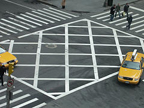
Ubicomp/Everyware
"I've seen a great deal of techno-optimism and even -utopianism around ubicomp, including a fair amount from people who should know better. But despite a deep folk understanding of some of the risks involved - Philip K. Dick was writing stories featuring recalcitrant doors and dilatory automated taxis in the late 1950s, and we've all heard of HAL9000 - there hasn't really been much in the way of people pushing back against the idea of ubicomp, in a measured and knowledgeable way. And so I've started to make some noise about what I see coming down the road, describing the reality I see lurking behind the marketing hype that's already beginning to build about the ostensible "conveniences" that await us."-Adam Greenfield interview on Studies and Observations.
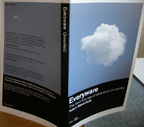
Everyware: The Dawning Age of Ubiquitous Computing by Adam Greenfield:
From the RFID tags now embedded in everything from soda cans to the family pet, to smart buildings that subtly adapt to the changing flow of visitors, to gestural interfaces like the ones seen in Minority Report, computing no longer looks much like it used to. Increasingly invisible but present everywhere in our lives, it has moved off the desktop and out into everyday life–affecting almost every one of us, whether we're entirely aware of it or not.
Author Adam Greenfield calls this ubiquitous computing "everyware." In a uniquely engaging approach to this complex topic, Greenfield explains how such "information processing dissolving in behavior" is reshaping our lives; brief, aphoristic chapters explore the technologies, practices, and innovations that make everyware so powerful and seem so inevitable.
If you've ever sensed both the promise of the next computing, and the challenges it represents for all of us, this is the book for you. "Everyware" aims to gives its reader the tools to understand the next computing, and make the kind of wise decisions that will shape its emergence in ways that support the best that is in us.
Adam Greenfield is principal of the New York City-based design consultancy Studies and Observations. He was previously lead information architect for the Tokyo office of Razorfish. His personal Web site, v-2.org, was nominated for a Chrysler Design Award in 2000.
[via Interactive Architecture dot org]
Posted by jo at 03:14 PM | Comments (0)
December 13, 2005
Speckled Computing
![]()
Spray on Networks
Speckled Computing offers a radically new concept in information technology that has the potential to revolutionise the way we communicate and exchange information. Specks will be minute (around 1 mm3) semiconductor grains that can sense and compute locally and communicate wirelessly. Each speck will be autonomous, with its own captive, renewable energy source. Thousands of specks, scattered or sprayed on the person or surfaces, will collaborate as programmable computational networks called Specknets.
Computing with Specknets will enable linkages between the material and digital worlds with a finer degree of spatial and temporal resolution than hitherto possible; this will be both fundamental and enabling to the goal of truly ubiquitous computing.
Speckled Computing is the culmination of a greater trend. As the once-separate worlds of computing and wireless communications collide, a new class of information appliances will emerge. Where once they stood proud – the PDA bulging in the pocket, or the mobile phone nestling in one’s palm, the post-modern equivalent might not be explicit after all. Rather, data sensing and information processing capabilities will fragment and disappear into everyday objects and the living environment. At present there are sharp dislocations in information processing capability – the computer on a desk, the PDA/laptop, mobile phone, smart cards and smart appliances. In our vision of Speckled Computing, the sensing and processing of information will be highly diffused – the person, the artefacts and the surrounding space, become, at the same time, computational resources and interfaces to those resources. Surfaces, walls, floors, ceilings, articles, and clothes, when sprayed with specks (or “speckled”), will be invested with a “computational aura” and sensitised post hoc as props for rich interactions with the computational resources.
Posted by jo at 12:11 PM | Comments (0)
November 23, 2005
Circuit City:
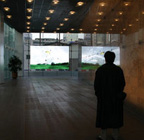
Tom Vanderbilt on Pixelated Architecture
"...The screen, along with the skyscraper, has for some time been one of the particular features of Asian modernity. The screen-centric vision of Los Angeles famously depicted by Ridley Scott in Blade Runner (1982) was, the director has noted, inspired by his time in 1960s Hong Kong, a paradoxical city whose pulsating electronic skyline overlooked a harbor, as Scott has described, filled with nineteenth-century fishing junks. But those screens were merely static vehicles for the transmission of commercial messages, mechanical upgrades of an older public-advertising tradition. What is most interesting about the screens I found in Seoul was that they were not merely architectural appendages broadcasting messages but architecture itself; not simply vehicles for delivering one-way information to a passive public but an active layer of the city's matrices of networks. To stand on a street was to stand on a street of a hundred screens, and by "screens" I mean the external manifestation—the collective user-interface—of the unseen digital flow pulsing down that same street, invisible but as much a part of the city experience as the concrete of the sidewalks..." From Circuit City: Tom Vanderbilt on Pixelated Architecture, Artforum.
Posted by jo at 10:51 AM | Comments (0)
November 21, 2005
UN predicts 'internet of things'
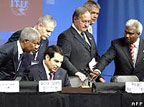
Ubiquitous Network Connectivity
""Changes brought about by the internet will be dwarfed by those prompted by the networking of everyday objects, says a report by a UN body. The study looks at how the use of electronic tags and sensors could create an "internet of things". The report by the International Telecommunications Union was released at the UN net summit in Tunis.
Thousands of delegates are discussing ways of narrowing the technology gap between rich and poor. "It would seem that science fiction is slowly turning into science fact in an 'Internet of Things' based on ubiquitous network connectivity," said the report. "Today, in the 2000s, we are heading into a new era of ubiquity, where the 'users' of the internet will be counted in billions and where humans may become the minority as generators and receivers of traffic."" Continue reading UN predicts 'internet of things' by Elizabeth Biddlecombe, BBC News. [via julianbleecker on eyebeam reblog]
Posted by jo at 02:19 PM | Comments (0)
November 14, 2005
Shoot me if you can
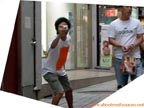
Replace a gun with fun
Shoot me if you can is an urban game inspired by first person shooting online video games. Replace a gun with fun, and shoot the opposing team with a cellular phone equipped with a digital camera. Participants; shooters are given a team color and phone number printed on the sticker. Shooters have to take a picture of the opposing team. If successful, she/he sends the picture to the opponent team member, via multimedia SMS system. Different rules exist for variations in game. Tactics are an important part as well as team work and understanding of the urban environment. This work is a commentary on abundance of digital image in our culture, desire to photograph and violence of surveillance camera. Active public participation in encouraged through website and the game. [via pasta and vinegar]
Posted by jo at 06:02 PM | Comments (0)
October 25, 2005
PlayAnywhere
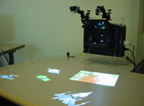
Portable Augmented Reality
Computer monitors are by no means an endangered species, but it is becoming increasingly apparent that they will soon be replaced for many uses by floors, walls and table tops. The latest evidence: a Microsoft Research scientist has developed a projector and computer vision system dubbed PlayAnywhere that projects interactive computer-generated images without the need for specially mounted cameras.
Researchers have been reducing the cost and complexity of the augmented reality systems in recent years. (See PCs augment reality, TRN June 26/July 3, 2002). The PlayAnywhere system goes further by packaging the components into a single portable unit that doesn't require calibration. The system consists of an NEC tabletop projector, an infrared light source, an infrared camera and a computer. The device projects a 40-inch diagonal image onto the surface it stands on.
Computer vision techniques allow users to use their hands to move, rotate and scale projected virtual objects. The system tracks shadows to determine where fingertips touch the surface; frame-to-frame pixel-level changes determine hand motion. The system also keeps track of sheets of paper in its view and can project images onto them.
The projector system could be used for games, educational software and other interactive graphical computer applications.
(PlayAnywhere: A Compact Interactive Tabletop Projection-Vision System, Symposium on User Interface Software and Technology (UIST 2005), Seattle, October 23-26, 2005) [posted on Technology Research News Roundup]
Posted by jo at 12:12 PM | Comments (0)
October 17, 2005
Songdo City
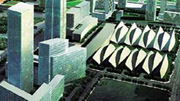
South Korea's "Ubiquitous City"
In what at first seems to be a throwback to the utopian urban visions of early 20th century futurism, South Korea is developing a "U-City" from the ground up, using bleeding-edge "ubiquitous" technology to monitor everything from citizens' medical records to garbage collection.
New Songdo City, being built on a man-made island 40 miles from Seoul, will feature pervasive computer technology throughout, driven by RFID tags and CDMA wireless communication. Although many Western observers would find the lack of privacy disquieting, Asian countries are more interested in the technological potential of such environments. Says John Kim, a Korean-American who is leading the planning for the U-City:
"U-life will become its own brand, its own lifestyle... [A resident's smart key] can be used to get on the subway, pay a parking meter, see a movie, borrow a free public bicycle and so on. It'll be anonymous, won't be linked to your identity, and if lost you can quickly cancel the card and reset your door lock.
"Residents will enjoy 'full videoconferencing calls between neighbors, video on demand and wireless access to their digital content and property from anywhere in Songdo.'"
With English as its official language, the city is designed to attract international business as a "free economic zone." The city will also feature ample open-space parkland and recreation facilities. The $25 billion project is slated for completion in 2014. Already, South Koreans are already applying for the chance to be among New Songdo's 65,000 residents. Sources: New York Times, Future Feeder. [posted by Brian on FutureWire]
Posted by jo at 09:17 AM | Comments (0)
October 14, 2005
Touch

Exploring User Centred Applications for NFC and RFID
Touch is a research project at the Interaction Design department at the Oslo School of Architecture and Design. Touch takes a user-centred approach to Near Field Communication (NFC). NFC is a technology that enables connections between mobile phones and real-world objects: bridging the gap between the real and the virtual. The project offers the possibility of radically simplifying existing applications and providing a new spectrum of local services through the mobile phone. At AHO we have multiple disciplines, including interaction design, industrial design, urbanism and architecture; a group with significant interest in the areas possibilities of NFC technology.
Posted by jo at 11:11 AM | Comments (0)
October 04, 2005
Ubiquitous Computing
![]()
Letter from Tokyo: Ubicomp 2005
"...The field of Ubiquitous Computing has gained strength as an often cited technology goal since Xerox PARC scientist Mark Weiser first defined it as a field in the late 1980s. Ubicomp is both a conference, and a discipline - and hence the term causes some confusion. 'Ubiquitous' (or 'pervasive') computing has been defined as 'technology that recedes into the background of our lives.' This excludes WIMP interfaces (acronym WIMP stands for Windows, Icons, Menus and Pointing device) and traditional desktops. But beyond that, there are no clear rules. Are mobile phones 'ubicomp?' Maybe. What about RFID? (Radio frequency identification, or RFID, is a generic term for technologies that use radio waves to automatically identify people or objects.) I'm defining these terms because Mark Weiser's ghost still hangs over the gathering more than five years after his death, both in the memory of people who knew him and in his inspirational words. The interpretation of those words, however, remains unsettled...
Ubicomp-the-conference and ubicomp-the-field are frustrating because they promise the impossible. The promise of computing technology dissolving into behavior, invisibly permeating the natural world around us cannot be reached. Technology is, of course, that which by definition is separate from the natural; it is explicitly designed that way. Technology only becomes truly invisible when, like the myriad of pens sold in Japan's department stores, it's no longer seen as technology at all. Deliberately creating something 'invisible' is self-defeating. I can think of few recent technologies as visible to the public as RFID, no matter how physically 'invisible' it might be." Read entire post [blogged by Elizabeth Goodman on Confectious]
Posted by jo at 04:36 PM | Comments (0)
September 27, 2005
The Singularity is Near
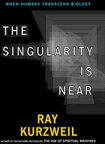
Merged with Our Technology
"Ultimately, we will merge with our technology. This will begin with nanobots in our bodies and brains. The nanobots will keep us healthy, provide full-immersion virtual reality from within the nervous system, provide direct brain-to-brain communication over the internet and greatly expand human intelligence. But keep in mind that non-biological intelligence is doubling in capability each year, whereas our biological intelligence is essentially fixed. As we get to the 2030s, the non-biological portion of our intelligence will predominate. By the mid 2040s, the non-biological portion of our intelligence will be billions of times more capable than the biological portion. Non-biological intelligence will have access to its own design and will be able to improve itself in an increasingly rapid redesign cycle." From Human life: The Next Generation by Ray Kurzweil, New Scientist (subscription required). See The Singularity is Near. [via smartmobs]
Posted by jo at 02:15 PM | Comments (0)
September 06, 2005
HIVE Networks Workshop + Launch
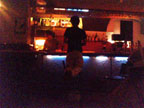
DIY Kit for Ubiquituous Computing and Free Networking
Alexei Blinov of Raylab and a group of collaborators have set out to create an exciting project, HIVE Networks, which promises to change the perception of ubiquituous or pervasive computing. HIVE combines the virtues of free software, free networks and open hardware to generate a framework for virtually any type of networked media application.
The group of independent programmers, artists and electronics specialists imagine swarms of intelligent network devices which all collaborate, facilitate media applications such as audio and video streaming and create clouds of free bandwidth using ad-hoc networking protocols.
The hardware basis currently is a customized Asus wireless hard drive. The firmware has been replaced with Linux and a cross-compilation tool kit has been developed. What this means is that any sort of application can be made to run on the cheap hardware which costs about 50 Euros a piece. For instance, a responsive environment could be built, using sensors, light, audio and video; or points of information exchange using wlan and bluetooth can be installed spread out in urban areas, because the individual units are cheap and replacable.
Blinov is keen to point out that the Asus boxes currently used are only the first step towards creating a framework for HIVE applications. The development is based on a set of key principles. The hardware has to be as cheap as possible and function according to widely used generic standards. The software has to be completely free and open source. Everything else is left to the creative imagination.
Raylab invites media practitioners to participate in application development for HIVE networks. Now that the basic toolkit has reached a phase of stability with increasing maturity, media practitioners - media activists, community groups, artists - are invited to come up with ideas for applications which Raylab will try to facilitate.
Ideally, in the next phase, this should all be done via a web based interface. The media practitioners do not have to get involved in deep technological development. All they need to do is click a few radio buttons to customize their own application which then will be compiled and installed on the device.
With HIVE Networks the traditional role, the artist who has an idea and gets a technician to develop the technical part, gets reversed. Here, creative technicians point out the future developments and offer a unique platform for artists. With HIVE ubiquituous computing takes on a new meaning. As the black box of technology is cracked open and made accessible, virtually anything is possible.
WORKSHOP: HIVE Networks - Swarms of information generating and processing devices
Friday, 09.09., 14.00 - 18.00
chip shop: application customization
Media practitioners, artists and developers are invited to share their visions of future applications for HIVE networks.
Both presentation and workshop are free. Please register if you want to participate in the workshop via email to: hive[at]kunstlabor.at
Posted by jo at 11:51 AM | Comments (0)
August 31, 2005
MINDPLAY:

Extended deadline for submissions
MINDPLAY is a one day conference on the social, intellectual and experiential dimensions of play and interaction in digital media environments. The conference focuses on mindful and playful relationships with digital media environments including mobile and ubiquitous media, new cinema, gameplay, wired performance spaces and networked communities. We encourage submissions of papers, practice-led research, poster presentations, demonstrations and installations. Selected papers may be published in a special issue of the journal Digital Creativity. Conference date: Friday January 20th 2006; Extended deadline for abstracts: Friday 30th September.
Posted by jo at 10:30 AM | Comments (0)
August 22, 2005
Ambient Computing and the Disappearing Computer

Dynamic Information Clouds in a Hybrid World
"ABSTRACT: There are three parts of my presentation. It starts with a review of (a) previously developed concept of cooperative buildings and Roomware® components as a new approach for designing the work environments of the future and its first example i-LAND. This is followed by presenting the EU-funded proactive intiative "The Disappearing Computer" (DC), a cluster of 17 related projects designing new people-friendly environments in which the "computer-as-we-know-it" has no role. Finally, a specific example of DC-intiative is presented, the project "Ambient Agoras: Dynamic Information Clouds in a Hybrid World." Here, we move beyond the more productivity-oriented support as, e.g., in i-LAND to a more experience oriented approach communicating atmospheres of social architectural spaces. Ambient Agoras aims at transforming places into social marketplaces ('agoras') of ideas and information, providing situated services, and feeling of the place ('genius loci') via a combination of ambient displays and mobile devices." From Ambient Computing and the Disappearing Computer by Norbert A. Streitz.
Posted by jo at 11:16 AM | Comments (0)
August 19, 2005
Toward a Global "Internet of Things"

Evolution or Revolution?
"...Most industry observers agree that the next wave of growth in the technology sector will be outside the realm of the traditional PC desktop. But many think of that growth in mundane terms -- with such things as cell phones and PDAs. In reality, we stand on the verge of an era that will see previously unimagined networked devices and objects. There are already some exciting applications that span the technology spectrum. NASCAR.com offers a Java applet-driven virtual dashboard that displays real-time wireless telemetry from cars during a race -- registering location, speed, RPM, braking, and more. The race cars have effectively become networked devices. Meanwhile, NASA, with the assistance of GE Medical, is now able to monitor real-time medical data (such as blood pressure, respiration, and heart rate) from its Space Shuttle astronauts. Even trees are on the network. Fifty battery powered "micromote" sensors now dangle from UC Berkeley's Mather Redwood Grove, part of a pilot program to monitor the health of groves of redwoods. The sensors register light, moisture, and temperature, enabling scientists to continuously monitor the microclimates surrounding given trees.
Such diverse networked "devices" offer concrete evidence of Metcalfe's Law. Robert Metcalfe, one of the developers of Ethernet, formulated that the usefulness of a network increases by the square of the number of nodes (users or devices) connected to the network. (Imagine how useful the telephone system would be if there were only two phones in the world!)
"In the future, everything of value will be on the network in one form of another," says John Fowler, Software CTO of Sun Microsystems. "And once they're on the network, we can aggregate data from those diverse devices, and then deliver that data to equally diverse devices -- in informative and compelling ways." And that's exactly what we're seeing today. "Most people think of a PC or a PDA as things connected to the network," continues Fowler. "But here we are connecting trees, race cars, and astronauts to the network. It's going to become a much more seamless spectrum."..." From Toward a Global "Internet of Things" by Steve Meloan, November 11, 2003.
Posted by jo at 07:45 AM | Comments (0)
August 16, 2005
TECHSTYLE NEWS: Issue #52 - August 15, 2005

Next Generation Mobile Technology
Techstyle News is a free monthly newsletter providing summaries and commentaries on stories related to the next generation of mobile technology and style, produced by Thinking Materials.
In this issue: (1) Hardwear News: Motorola and Oakley announce cellphone sunglasses; Texas Instruments launches mobile single-chip solution; MP3 sunglasses from Global American Technologies; Digital locket from Beatsounds; Digital picture pendant from Spectare; (2) Softwear News: IBM software lets you carry your PC around your neck; and (3) Events: Mobicom 2005 in Cologne; Ubicomp 2005 in Tokyo; Wearable Futures in Newport.
HARDWEAR NEWS
MOTOROLA AND OAKLEY ANNOUNCE CELLPHONE SUNGLASSES
Motorola and Oakley has announced the expected availability of RAZRWIRE Bluetooth eyewear in early August. The Bluetooth module is designed to complement the overall look of the sunglasses, creating truly wearable technology. The controls include two volume buttons and a single button used to handle incoming and outgoing calls. RAZRWIRE allows you to carry on phone conversations while up to 30 feet away from your compatible Bluetooth-enabled cell phone. Bluetooth Sniff Mode technology increases the battery life of RAZRWIRE, offering continuous talk time of more than five hours and standby time of up to approximately 100 hours.
http://oakley.com/about/razrwire/
TEXAS INSTRUMENTS LAUNCHES MOBILE SINGLE-CHIP SOLUTION
TEXAS Instruments has announced the launch of its single-chip mobile solution. Manufacturers such as Nokia, Motorola, and Ericsson are expected to launch handsets based on the solution in nine months. Mr Tom Engibous, Chairman, said: "The single-chip solution will bring down power and space consumption by 50 per cent and cut costs by 30 per cent". With this, he said, there is the possibility of $20 cell phones on the horizon. The small chips can be easily integrated, bringing phone technology to all kinds of products.
http://news.com.com/Is+a+20+cell+phone+on+the+horizon/2100-1039_3-5823239.html
MP3 SUNGLASSES FROM GLOBAL AMERICAN TECHNOLOGIES
Global American Technologies have launched the Fio MP3 sunglasses. The retail prices are $200 to $400 at storage capacities of 128MB up to 1GB, include 3D stereo sound earbuds in each arm, support MP3/WMA/ADCPM and have a reported battery life of 8.5 hours. Transfer is via USB 2.0 to either a Mac or a PC, with an integrated microphone providing digital voice recording capabilities.
http://www.techtree.com/techtree/jsp/article.jsp?article_id=5284&cat_id=505
DIGITAL LOCKET FROM BEATSOUNDS
The Digital Locket EMP-Z II Plus from BeatSounds tries to be more than just a wearable MP3 player. This tiny music player has a small, oval color screen that can display a photo. The Digital Locket measures 2 inches by 1.8 inches, weighs 0.9 ounce and has a battery that lasts up to 16 hours before it needs recharging. It can play digital audio files in the MP3 or Windows Media audio formats and comes with its own software for transferring photos and music from a computer over a USB connection. An FM radio tuner and a voice recorder are also tucked inside. Prices start at $80 for the 256-megabyte version and go up to $150 for the model with a full gigabyte of memory.
http://beatsounds.com/Pb/index.asp?CurrentCatID=C1035889862578133
DIGITAL PICTURE PENDANT FROM SPECTARE
The Pixi Digital Picture Pendant is a necklace with a 1-inch, 96 x 64 pixel LCD screen and enough memory (512 KB) for storing up to 54 extremely low-res digital photos. For viewing up to 2 hours in slideshow mode, or longer in manual mode. The pendant is USB 1.1 compatible and compatible with photos in JPEG format.
http://chipchick.blogs.com/chip_chick/2005/08/pixi_digital_pi.html
SOFTWEAR NEWS
IBM SOFTWARE LETS YOU CARRY YOUR PC AROUND YOUR NECK
Researchers at IBM are testing software that would let you tote your home or office desktop around on an iPod or similar portable/wearable device so that you could run it on any PC. The virtual computer user environment setup is called SoulPad, and consumers install it from a x86-based home or office PC. SoulPad uses a USB or FireWire connection to access the network cards for connecting to the Internet, the computer's display, the keyboard, the main processor and the memory, but not the hard disk. After the person disconnects the system, SoulPad saves all work to the device, including browser cookies or other digital signatures that a PC keeps in its short-term memory.
http://www.research.ibm.com/WearableComputing/SoulPad/soulpad.html
EVENTS
MOBICOM 2005 IN COLOGNE
ACM MobiCom 2005 is dedicated to addressing the challenges in the areas of mobile computing and networking. This single-track conference serves as an international forum addressing networks, systems, algorithms, and applications that support the symbiosis of mobile computers and wireless networks. It will be held August 28 through September 2 in Cologne. Speakers include representatives from Bell Labs, Daimler Chrysler, NTT DoCoMo and MIT. Particularly interesting could be the panel on Wearable computing with, among others, Steve Mann.
http://www.sigmobile.org/mobicom/2005/
UBICOMP 2005 IN TOKYO
UbiComp 2005, the Seventh International Conference on Ubiquitous Computing, will be held September 11-14, 2005 in Tokyo. The conference provides a forum in which to present research results in all areas relating to the design, implementation, application and evaluation of ubiquitous computing technologies. Papers include submissions from Intel, NTT, Nokia, Microsoft and IBM. There are also thirteen workshops to participate in.
http://ubicomp.org/ubicomp2005/
WEARABLE FUTURES IN NEWPORT
Wearable Futures is an interdisciplinary conference, to be held in Newport on 14-16 September, which aims to bring together practitioners, inventors, and theorists in the field of soft technology and wearables including those concerned with fashion, textiles, sportswear, interaction design, media and live arts, medical textiles, wellness, perception and psychology, IPR, polymer science, nanotechnology, military, and other relevant research strands. We will be examining how some broad generic questions will be explored in relation to wearable technology including but not restricted to: aesthetics and design, function and durability versus market forces; the desires, needs and realities of wearable technologies; technology and culture; simplicity and sustainability; design for wearability.
http://artschool.newport.ac.uk/smartclothes/wearablefutures.html
Posted by jo at 09:57 AM | Comments (0)
MAY YOU LIVE IN INTERESTING TIMES
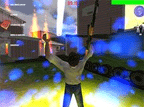
Exploring Digital Technologies in the Context of Public/Shared Spheres
MAY YOU LIVE IN INTERESTING TIMES is Cardiff’s inaugural festival of creative technology - a three-day programme of events being held across the capital. The festival is being developed between Chapter and Bloc (Creative Technology Wales) and includes a two-day conference, new commissions, residencies, screenings, and artists’ projects in public sites across the city.
Artists are increasingly engaged with or inspired by digital technology - exploring consumer and communication technologies such as the worldwide web, mobile networks, file sharing, and computer gaming. Because digital technology is a participatory medium with global reach, artists tend to explore digital technology in the context of public and shared spheres. Often digital art is situated somewhere between public art and street culture where the technology itself is used as a ‘site’ for the production and presentation of art works. Although digital technology is often claimed to go beyond physical limitations, engagement with technology is always embedded in real spaces, whether this is explored from a user or network perspective.
Artists include: Blast Theory, Anri Sala, Grennan & Sperandio, TJ Wilcox, Jen Southern & Jen Hamilton, Scanner, Sarah Morris, Michelle Teran, Eddo Stern, Stefhan Caddick, Nina Pope & Karen Guthrie, Tim Davies, Rosalind Nashashibi, Tenant Spin, Andy Fung, Paddy Jolley, Mircea Cantor, STAR Radio, Valérie Jouve, Chris Evans, Mike Mills, Artstation, and many more.
Conference day 1: 28 October - Locative media and emplacement Speakers include: Prof Michael Corris, Head of Art & Photography, University of Newport; Claire Doherty, Director, Situations; Nina Pope, artist; Heath Bunting, artist; Giles Lane, Proboscis; Steve Benford, Professor in Collaborative Computing, University of Nottingham; Dr Sarah Green, Social Anthropologist, University of Manchester; Jen Southern & Jen Hamilton, artists.
Conference day 2: 29 October - Gaming Speakers include: Ju Row Farr, artist, Blast Theory; Stuart Nolan, researcher; Christopher Sperandio, artist; Eddo Stern, artist; David Surman, Lecturer in Computer Games Design, University of Newport; Alex Mayhew & Emma Westecott, Games Producers & Directors.
Conference Prices: £50 per day / £90 weekend ticket – organisations; £30 / £50 – early bird booking before 7 October £20 per day / £30 weekend ticket – individuals /concs; £15 / £25 – early bird booking before 7 Oct Party, The Point, Cardiff, 29 Oct, 8pm: Special Guests Scanner, Michelle Teran, Proober Glombat, Cymbient, Christopher Rees DJs.
The site will feature live streaming, artists’ projects, downloads, full biographies and images, conference booking and travel details, press section and the chance to receive regular updates on festival activity.
For further information about the programme and conference please contact: Gordon Dalton, Festival Coordinator: gordon@mayyouliveininterestingtimes.org 44 (0) 29 2031 1059 / 0779 234 1654
The festival is a Cardiff 2005 event and is presented with the support of: Cardiff County Council, Millennium Commission, the Arts Council of Wales, WDA, Cywaith Cymru . Artworks Wales, BBCi, Creative Mwldan, Millennium Stadium, Mute, G39, The Big Sleep, Elfen, Zenith Media, UWN, National Museums and Galleries of Wales, Sequence, Coolpants, Ping Wales, Oriel Mostyn and @Wales. http://www.bloc.org.uk/cgi-bin/showbig.cgi?id=55
Posted by jo at 09:51 AM | Comments (0)
August 12, 2005
Phones Make Korea a Silent Society
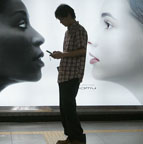
Living Without Saying a Word All Day
"The mobile phone bill of college student Oh Su-hyeon (21) for the month of July lists 648 text messages and four hours and 55 minutes of talk -- an average of 21.6 text message a day and an average nine minutes and eight seconds of conversation. ”I used to spend about two hours on the phone every day, but now I send text messages. All you need to do is state your business, there's nothing superfluous and it's convenient." [...]
If in an age of near-ubiquitous communication people have become paradoxically quiet, it is because means of communication that replace the spoken word, like chat programs and text messengers, are cheap, convenient to use and accessible everywhere. There are people who say they could live comfortably without saying a word all day, and who send so many SMS and chat online so much that sometimes they find it awkward to talk. Yet it is the telephone that is at the heart of these changes, a device that is rooted more than anything else in the attempt to allow people to talk. [...]
Cell phones with GPS navigation systems have also created a world where no one needs to ask directions, and DMS systems allowing people to watch TV on their phones have replaced gossip as a way to kill time. But the changes are taking place elsewhere too. Manned subway ticket booths are being visited by much fewer people. Cho Dong-hwan, the manager of Gwanghwamun Station on subway Line 5, says of the 28,000 passengers who use Gwanghwamun Station daily, over 80 percent use transport cards. ”The overwhelming majority of passengers using the ticket window are asking for senior citizen tickets.“
There are concerns that the silent society could aggravate alienation and isolation. But experts say there is no need to expect the worst: it is merely that communication is changing, from face-to-face to other forms, yet the flood of communication itself has not stopped. [...]
Yonsei University sociologist Kim Ho-gi says young-generation ”cool“ means a preference for writing over speech. ”Speech is loaded with feeling, and because young people prefer communication styles that convey meaning simply and clearly while keeping their own emotions in check, they like communicating through text messages." Link [via ratchet up]
Posted by jo at 09:09 AM | Comments (0)
August 10, 2005
Exploring the Content Network
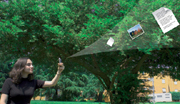
Interactions Within a Personal Network of Devices
In the future, our electronic devices will be networked together and all our digital content will be available when we need it. We'll have thus ever more data to sift through. Exploring the Content Network, Thomas Stovicek's thesis project, is a a set of screen-based software and hardware interactions between devices that looks at new ways to access, view and filter this growing store of information.
Devices are physically manipulated and keywords used to make a more intuitive way to access content- text, photos, videos etc. The coordinating system, called Content Network, connects a group of devices and gives them access to each others' content. One of its elements, Navigation Through Related Tags, lets people find their content based on keywords instead of folders.
Combining Devices to Navigate Content uses very short-range wireless between the devices to detect how they are interacting and triggers data transfer and shared actions: placing one person's mobile phone over another's, for instance, bring up, on both screens, a combined calendar highlighting available times for a proposed meeting.
"Related tags allow to sort and organize your content by keyword. Physical interactions helps by using intuitive actions to interconnect the devices of a group of people, to show only data relevant to, and organized for, the task in hand. These concepts, which apply to both work and social groupings, demonstrate new potentials in navigating your content without the fear of information overload normally associated with it." [blogged by Regine on we-make-money-not]
Posted by jo at 08:51 AM | Comments (0)
August 01, 2005
Surveillance
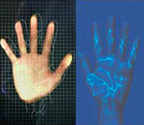
The Holy Grail Is A Universal Sensor
Here's the good stuff from a massive and chilling report on the future of surveillance from Business Week Online:
"Britain has 4 million video cameras monitoring streets, parks, and government buildings, more than any other country. London alone has 500,000 cameras watching for signs of illicit activity. [...]
Research laboratories envision tools that could identify and track just about every person, anywhere -- and sound alarms when the systems encounter hazardous objects or chemical compounds. Many such ideas seem to leap from the pages of science fiction: An artificial nose in doorways and corridors sniffs out faint traces of explosives on someone's hair. Tiny sensors floating in reservoirs detect a deadly microbe and radio a warning. Smart cameras ID people at a distance by the way they walk or the shape of their ears. And a little chemical lab analyzes the sweat, body odor, and skin flakes in the human thermal plume -- the halo of heat that surrounds each person. [...]
Camera phones, nanny cams, and even satellite photos are commonplace. Biological sensors are flooding into households in the form of tests for HIV, pregnancy, and diabetes -- some of which can relay data to a doctor -- and soon there will be far more sensitive DNA-based tests. Next up are radio-frequency identification (RFID) tags. They're showing up in stores to help track inventory, and 50 people in the U.S. have had them planted under their skin to broadcast their ID and medical data, in case of an emergency. [...]
One great worry is that those who stand out from the norm or express unpopular views, minorities, the poor, or just the ill-mannered, may get stomped in new and surprising ways. A recent incident in South Korea shows how this can play out. A subway commuter posted on the Internet some cell-phone photos he took of a passenger who had refused to clean up after her dog relieved itself during the ride. In no time, a vigilante mob on the Web identified her by her face and the purse she was carrying, and she became the object of national vilification. “You can move into a surveillance society one tiny camera at a time,” says Deirdre Mulligan, director of the Samuelson Law, Technology & Public Policy Clinic at the University of California at Berkeley. [...]
Experts disagree about when the most visionary tools to thwart terrorist acts will arrive on the market -- and whether they will deliver on their promise. Sensors that can detect bombs, radiation, and toxins exist today, and will be far more sophisticated a decade from now. But strewing them across every city in America would cost untold billions of dollars. High-tech electronic eavesdropping on communications networks can be effective, but only if terrorists use telecom systems. And even with improvements in cameras, biometric devices such as iris scans, bomb sniffers, and tracking software, it will be years before they can pick a terrorist out of a crowd. In short, the march toward a surveillance society may be inevitable, but no simple cost-benefit equation can assure us that the sacrifices will be worth it. We'll be debating the point for decades to come. [...]
In the quest to sort bad guys from good, scientists are poking ever more intimately at the core of each person's identity -- right down to the DNA. One day people's distinctive body odor, breath, or saliva could serve as an identifier, based on the subtle composite of chemicals that make up a person's scent or spit. [...] scientists are creating super-sensors to pick up myriad molecules released at low concentrations that constitute human scents, including carbon dioxide, acetone, ethanol, and sulfur. To capture them, they poke tiny pores into glass -- as many as 10,000 on a chip the width of a pencil eraser -- each tailored to the size of the molecule. Excited by a laser, the chemicals trapped in the pores emit different colors, and computers can then analyze the resulting pattern.
Dental researchers are attacking the challenges of identification and diagnosis from another vantage point -- the mouth. They're studying whether saliva contains markers for various diseases. If the technology works, it has additional potential for biometric applications, too. Spit contains many of the proteins, nucleic acids, and other substances that are found in blood. While they are present in fainter quantities, they can also be sampled less intrusively. [...] they can detect in human saliva some 3,000 messenger RNAs, molecules that carry genetic information within a human cell. These molecules perhaps can serve as markers for disease, or perhaps for identity, just like DNA. And they are often easier to detect. About 180 RNA markers are common across all individuals, but the remainder can differ. [...]
Biometrics bring a host of other troubles. As they become used more and more in office access, ATM passwords, passports, and ID cards, their value increases, and so do efforts to steal or spoof them. And because biometrics are cloaked in science, matches may acquire an unearned aura of dependability. Recently, cryptographers in Japan showed that common fingerprint-based systems can be easily duped using simple molds of melted Gummi Bear candies. [...]
Despite the many failings of biometrics, the federal government is encouraging scientists to fashion them into covert surveillance tools. Face recognition -- the most obvious way to track people because it's how humans do it -- is still dogged by problems matching images that may be distorted by a smile or ill-placed shadow. While scientists work out those glitches, others are improving iris-based technology for surveillance at a distance. Though computers can easily find eyes on a face, today's systems can't scan irises from afar as people rush through a crowd. [...]
Another hope is that certain characteristic movements may be recognizable at a distance. Taking a page from Monty Python's Ministry of Silly Walks, the U.S. Defense Advanced Research Projects Agency, the research body credited with inventing the Internet, funds work on software that could identify individuals by their strides. Researchers measure the silhouette of the torso, the swinging of the shoulders and legs, and the time it takes to move through a single step. [...]
The most serious privacy breaches are almost all linked to the proliferation of fast and inexpensive data processing and storage systems. The worst problems arise when each bit of information an individual gives up over the course of a day -- from the E-ZPass scans on the morning commute to the credit card purchase at Starbucks (SBUX ) to the logging of PC keystrokes at work -- get tied across various databases to create a detailed dossier of an innocent Joe's daily activity. [...]
This is just one of many measures that trigger a Big Brother alert. One of the hot buttons is eavesdropping. An emerging wireless technology called software-defined radio has the power to make cellular phones compatible with any network standard, but also opens new frontiers of snooping. The commercial merits of the technology are self-evident: Say good-bye to dead zones and lack of interoperability between police and firefighter radios. But the technology also enables superscanners that can be tuned to pick up the images on your neighbor's computer. That's possible because all computers emit stray radiation. With software-defined radio even amateurs could probably design equipment that could spot somebody porn-surfing in the next apartment. The technology can also make it easier to turn the cell phone of a spouse into a bug when it's not in normal use. [...]
Advances in many surveillance technologies piggyback on progress in fields such as wireless signal processing, nanotechnology, and genomics. Even plain old digital cameras are hotbeds of innovation. The imaging sensors in consumer cameras have been achieving ever-higher resolutions, while plunging in price. Because the gadgets are so engaging, crowds end up participating in surveillance efforts. Witness spectators holding cameras and phones aloft whenever news breaks -- an act that may aid investigations, or hold police misbehavior in check. [...]
Improved picture quality has given a boost to Viisage rival Identix Inc., allowing it to add in minute details of the skin to increase the accuracy of facial recognition. It divides a small area on the face into a 400-block grid, and then inspects each block for the size of skin pores, wrinkles, and spots. And using an infrared camera, researchers at A4Vision Inc., a Sunnyvale (Calif.) startup funded in part by In-Q-Tel, the CIA's venture fund, cooked up a 3D approach. Its system creates a topographical map by projecting a grid pattern of infrared light onto a face, and matching the features.
Strides in wireless signal processing are bringing the power of astronomical instruments to homeland security. Giant radio telescopes today listen to the faint energy waves emanating from stars billions of light years away. The first earthbound applications of this electronic wizardry will be airport scanners that scrutinize passengers' bags. The principle is simple: All matter gives off so-called background radiation, or millimeter-wave heat, whether it's a supernova or a switchblade. [...]
A kindred technology can “see” the molecular composition of matter using extremely short wavelengths of energy. When a machine made by Picometrix Inc. shines these terahertz waves on a target, its molecules resonate at a telltale frequency. One plastic explosive, for instance, vibrates at 800 gigahertz. T-rays pose no radiation hazard because they don't penetrate human skin. But people being scanned will appear naked on the monitor unless the system is programmed to cover up private parts. [...]
The Holy Grail is a universal sensor, small and cheap enough to scatter in public places, and smart enough to sniff out anything that comes its way, without being preprogrammed to find specific molecules. Nobody is close to that goal yet, but Sandia National Laboratories has designed a lab-on-a-chip that detects a variety of both chemical and biological agents. It has skinny microchannels etched in its surface. When a gas or liquid moves through the tiny pipes, it collides with special material, and how much that slows the flow betrays the identity of the fluid. Sandia is now developing this technology to monitor the Contra Costa County (Calif.) water supply.
U.S. Genomics Inc. in Woburn, Mass., claims that it is hot on the heels of a universal sensor. Its prototype uses particular molecules to tag important DNA sequences in the genes of lethal pathogens, such as anthrax. Then, primed with a fluorescent dye, those sequences light up, and a photo detector compares the pattern of illumination with a library of known bioagents." [blogged by John on Ratchet Up!]
Posted by jo at 10:20 AM | Comments (0)
July 27, 2005
Social Machines

Continuous Computing
"...After a decade of hype about "mobility," personal computing has finally and irreversibly cut its bonds to the desktop and has moved into devices we can carry everywhere. We're using this newly portable computing power to connect with others in ways no one predicted--and we won't be easily parted from our new tools...
There is something different about the latest tools. They are both digital, rooted in the world of electrons and bits, and fundamentally social, built to enable new kinds of interactions among people. Blogging, text messaging, photo sharing, and Web surfing from a smart phone are just the earliest examples. Almost below our mental radar, these technologies are ushering us into a world of what could be called continuous computing--continuous in the usual sense of "uninterrupted," but also in the sense that it's continuous with our lives, in all their messy, social, biographical richness..." From Social Machines by Wade Roush, Technology Review, August 2005.
Posted by jo at 11:01 AM | Comments (0)
July 25, 2005
Mediated Spaces

When Space Understands and Participates
"...The emerging relationship between people and pervasive computation is sometimes idealized as a "smart space": the seamless integration of people, computation, and physical reality. This paper focuses on a particular kind of smart space, the "mediated space," in which the space understands and participates in multiperson interaction. Mediated spaces will expand human capability by providing information management within a context associated with that space. The context will be created by recording interaction within the space and by importing information from the outside. Individuals will interact with the space explicitly in order to retrieve and analyze the information it contains, and implicitly by adding to the context through their speech and gesture. Achieving the vision of mediated spaces will require progress in both behind-the-scenes technology (how devices coordinate their activities) and at-the-interface technology (how the space presents itself to people, and how the space deals with multiperson interaction). This paper explores the research challenges in both of these areas, examining the behind-the-scenes requirements of device or manifestation description and context maintenance, as well as the interface problems of metaphor and understanding natural human-to-human spoken interaction." From Turning Pervasive Computing into Mediated Spaces by W. Mark, IBM Systems Journal.
Posted by jo at 09:51 AM | Comments (0)
July 18, 2005
InteractiveSpaces.net
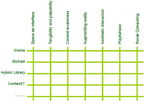
Concepts for Future Interactive Spaces
InteractiveSpaces is an interdisciplinary research center bringing together architecture, engineering, and computer science with the research mission to create new concepts for future interactive spaces. InteractiveSpaces.net also bring together companies and public researchers in a R&D activities leading to new products and services for specific domains. Research themes include:
Space as Interface: Through the emergence of pervasive computing our surrounding space contains both physical and virtual proporties. Interacting with these environments require a new way of understanding the relation between space and technology. To us interactions should not only be limited to simple displays but be a part of and take place in the space, and in that way using the space as the interface. This is done by combining the spatial and technological properties with the user as an interacting device – speaking to, gesturing with, moving in and touching the surrounding space. That way our interactions with technology gets a closer relation to the environments they are applied to.
Tangibility and palpability
The current focus on invisible computing and ambient intelligence does not take into account that users need to understand their environment and wish to be in control of the situation. To achieve comprehension and control we develop tangible and palpable environments. Tangible and palpable environments share similarities with pervasive and ubiquitous computing environments in that they consist of configurations of a number of components running on different devices in ephemeral interaction to serve certain purposes in a given context #lang sætning. However, tangible and palpable interactive spaces are different in that they are not based on the assumptions that computing is invisible, autonomous, and intelligent on behalf of its users. Instead we strive to create ready-to-hand understandable, visible and tangible services integrated in interactive spaces. We augment spaces such that they respect the qualities of the physical world.
Context aware interaction
We create seamless access to information and services in spaces without cumbersome logon and user interfaces that adapt to users based on e.g. location and profiles. We make the environments that carry user files and store information produced by users based on the context rather than try to let the users carry all their data on portables and the like. Computing support is called context aware, when the available services and information are provided based on a sense of the context, i.e. the time of day, the weather, the light, the user’s location, tasks, preferences etc. Context may be sensed by tracking the location of users and objects and by retrieving status, profile, or preference information from users’ active badges, PDAs or mobile phones. Services in an environment use the context-awareness to adapt functionality and user-interfaces of services to the context. The environments we develop will take advantage of context awareness and provide the users with relevant services.
Augmenting reality
The focus is on seamless augmentation of the physical environment with digital information and services without spoiling the affordances of the physical artefacts and the environment. Techniques include tagging and labelling the physical world with RFID or visual markers to link to digital information. Digital information may be superimposed on real world objects with different techniques, such as project or see-through displays.
Aesthetic interaction
The typical image of computers is closely related to grey boxes on our desktops. owever, as technology moves beyond the work environment into the domestic and cultural realms of life, the roles and ideals of information technology must reflect the experiential aspects of life. Through designing for aesthetic interaction we wish to make technology serve and enrich people's everyday life. Aesthetic interaction emphasizes a focus beyond functionality of computational devices taking departure in the more subtle and poetic sides of life. It aims for creating involvement, experience, surprise and serendipity in interaction with everyday artifacts and interactive spaces.
Aesthetic interaction
The typical image of computers is closely related to grey boxes on our desktops. owever, as technology moves beyond the work environment into the domestic and cultural realms of life, the roles and ideals of information technology must reflect the experiential aspects of life. Through designing for aesthetic interaction we wish to make technology serve and enrich people's everyday life. Aesthetic interaction emphasizes a focus beyond functionality of computational devices taking departure in the more subtle and poetic sides of life. It aims for creating involvement, experience, surprise and serendipity in interaction with everyday artifacts and interactive spaces.
Playfulness
A playful approach enhances people’s imaginary resources enabling new ways of perceiving and adopting the surrounding world. In our research playfulness is considered to reach beyond a temporary amusing activity; play is characterised as a voluntary, structured, purposeful and pleasurable activity involving the imaginary. It challenges and transcends established paradigms and ideas, and shares aspects of informal learning. The ambition is to design playful IT enhanced environments and artefacts that will enable new ways of seeing and support the person engaging with a system to take initiative and challenge its rules and conceptions.
Social Computing
Computing potentials are moving beyond the office into the spatial context of homes, institutions and the urban environment. Traditionally computers and artefacts have been designed for the individual user. However, the migration of technology towards a social environment, stresses the need for focusing on the use of technology in a social and spatial context. Taking point of departure in domestic and public contexts, interactivespaces design environments supporting social interactions, e.g. sharing information and knowledge and establishing new relations and contacts.
Posted by jo at 08:40 AM | Comments (0)
July 06, 2005
Ambient Intelligence:

Changing Forms of Human-Computer Interaction and their Social Implications
"Abstract: Ambient intelligence appears poised to cause remarkable changes in the way people live. With digital information, the ease of interaction between humans and computers can be greatly increased by broadening the interface media available and allowing for mobile and portable communication free of inhibiting wires and stationary units. Additionally, some forms of ambient intelligence allow computers to adapt to their user's preferences. The result of ambient intelligence is ultimately a more empowered computer with the benefits of added convenience, time and cost savings, and possibilities for increased safety, security, and entertainment. This technology has the potential to significantly impact business and government processes, as well as private life. The paper describes developments to date in ambient intelligence and its closely related counterpart, ubiquitous computing and communication. It discusses the driving forces behind this digital information technology, describes the equipment and devices involved, the obstacles to implementing ambient intelligence on a large scale in real-world scenarios, and considers the future outlook. The authors believe that the introduction of this digital information technology will have wide-ranging implications, which will for the most part be beneficial and valuable." From Ambient Intelligence: Changing Forms of Human-Computer Interaction and their Social Implications by Mahesh S. Raisinghani, Ally Benoit, Jianchun Ding, Maria Gomez, Kanak Gupta, Victor Gusila, Daniel Power and Oliver Schmedding; Journal of Digital Information, Volume 5 Issue 4
Posted by jo at 12:03 PM | Comments (0)
February 28, 2005
RESONANCES AND EVERYDAY LIFE:
Ubiquitous Computing and the City
Abstract: Ubiquitous computing seeks to embed computers into our everyday lives in such ways as to render them invisible and allow them to be taken for granted, and social and cultural theories of everyday life have always been interested in rendering the invisible visible and exposing the mundane. Despite these related concerns, social and cultural studies remain in the background of discussions of ubiquitous technology design. This essay seeks to introduce researchers in both fields to each other, and begin to explore the ways in which collaboration might proceed. By exploring mobile and ubiquitous technologies currently being used to augment our experiences of the city, this paper investigates notions of sociality, spatialisation and temporalisation as central to our experiences of everyday life, and therefore of interest to the design of ubiquitous computing." Resonances and Everyday Life: Ubiquitous Computing and the City (DRAFT) by Anne Galloway. [via]
Posted by jo at 10:36 AM | Comments (0)
Ad Hoc Information Spaces
Temporary Networks
"Abstract: We describe the concept of ad hoc information spaces as a way of distributing information in an environment depending on user mobility and relative location. Ad hoc information spaces are realized using a decentralized approach to ubiquitous computing, which is based on functionally self-contained devices and ad hoc networking. Users are able to contruct and manipulate the properties of these information spaces by means of moving and manipulating a variety of devices. In order to explore the possibilities of using ad hoc information spaces to support group collaboration, three prototypes were developed: the Hummingbirds, the Generalized Hummingbirds and the NewsPilot. These are described along with some of the empirical findings that support their design." Ad Hoc Information Spaces - Johan Redström, Lars Erik Holmquist, Per Dahlberg and Peter Ljungstrand. [via]
Posted by jo at 10:29 AM | Comments (0)
January 28, 2005
wireless makes local connection

DIY Community Node:
Welcome to Park Bench TV!. A physical portal in Central London, a specific bench within clear range of a wireless internet signal...come down and log on.
This is a public bench in the middle of a quiet square London near Tottenham Court Road, –- where you can access the internet and tap into a local community of people, living and working in the area - and eat your lunch.
Find out more about the project and what its about. Come and sit on the bench with your laptop, and access the internet and see programmes about the local area - or just surf and pick up email.
Chat in the on line forum and discuss local issues or comment on the project
View video programmes using the Park Bench TV Channel
Make and add your own new programmes about the area to Park Bench TV
Find out about wireless internet technology and how to use it
Get on Park Bench TV and become a local celebrity!
The aim is to allow local people to access content about their immediate location and also begin to develop a way for visitors to gain an insight into our area.
This includes interviews with local people including the gardeners in the square, local residents, and other community figures.
If you want to appear on the channel and be interviewed, access the forum and ask us! We will be happy to meet you.
The wireless internet access point has been set up and specifically installed to allow access for users outside in the street, a local community and tourist service.
Open Access
How you can contribute..
The best place to ask detailed questions is the forum.
The channel will be using the Frequency Clock - a media player that allows us to organise video clips into a channel. and which will also allow users to upload and schedule their own material.
If you want to know how to contribute programme material and details about how to access it..
All of the content on the channel is focusing on the community, facilities, people, workers, and visitors to the area; tourists, lunchtime visitors, local gardeners and sometimes pigeons are the stars.
You can access the channel directly from the bench using a laptop and a WiFi card connected to the internet.
You can watch the content from the internet anywhere in the world – and if you want you can contribute to the channel – the only rule is that the content has to be about the area local to the bench and it's immediate surroundings.
As the content is all locally specific – and some of it will not always make sense or be understood when viewed from outside the benches immediate location.
So you might want to visit the bench and watch the channel from there – and maybe make some content, recording your stay with a cam corder, which you can then upload to the channel.
The channel will play the following file types : Real Player, Windows Media, Flash and Quicktime.
Join the forum and ask about what's going on - whether your in the area or not.
Posted by michelle at 11:39 AM | Comments (0)
December 27, 2004
netzwissenschaft
![]()
Emerging Infrastructures of All (Inter)net Research
Dr. Reinhold Grether's network research | netzwissenschaft site maps the "emerging infrastructures of all (inter)net research endeavours. net.science as an anthropology of connectivity is trying to overcome the constraints of specialist method transfers on net matters. the protuberance of technical networks necessitates a professionalization of human net knowledge. neither the isolation of concepts as in basic research nor the encapsulation of processes as in applied sciences will ever be able to adequately describe the complex autopoiesis of networks. net.science is undoubtedly developing into a scienza nuova of its own right."
Check out his Mobile Art and Virtual Performance research areas.
Posted by jo at 04:45 PM | Comments (0)
October 19, 2004
Teri Rueb

Connecting via Fluid Space
"The integration of data space and real space through mobile media and location-based systems brings back into circulation a whole host of communication rituals and interaction styles that engage the body, movement and context-sensitive exchanges. With the increasing ubiquity of wireless and mobile media, space is imagined as a Hertzian soup – a space of flows that defies the clear and fast boundaries of visual space and concrete form, instead emphasizing our connectedness in and through the social body." Continue reading Syncopated space – wireless media shaping human movement and social interaction by Teri Rueb.
As a digital artist, Teri Rueb explores the relationship between sound, space and human movement in location-aware installations and large-scale responsive spaces. She exhibits and lectures widely in international venues and is a professor in the graduate Department of Digital Media at the Rhode Island School of Design (RISD).
Posted by jo at 08:30 AM | Comments (0)
October 13, 2004
Instant Mess
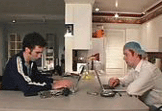
Mediated Conversation
Watch this Quicktime video.
via Red Ferret, reblogged by emily at textually.org
Posted by jo at 02:49 PM | Comments (0)
October 11, 2004
Human Ethernet
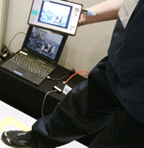
Streaming the Body
NTT demoed their human body data transmission technology at CEATEC JAPAN 2004. The technology detects weak electric fields in a human body by using an optical electric field sensor and provides the data communication speed of about 10Mbps (much faster than 3.7Kbps, the speed Matsushita Electric Works' technology enables.) The system also uses the TCP/IP protocol, making a human body equivalent to 10Mbps ethernet. However, unlike Matsushita's technology that is ready for commercial use, NTT's technology may need some work before it can be commercialized.
It works as follows: You step on a copper platform containing a server computer and hold a computing device, then data are sent from the server through your body to the computing device. For example, you can view streaming video transmitted through you body on your handheld device.
Via RFID in Japan < IT Media. Reblogged by Regine from we make money not art
Posted by jo at 11:06 AM | Comments (0)
October 04, 2004
Distributed Form: Network Practice
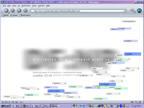
Dominant Spatial Paradigm
Distributed Form: Network Practice, University of California, Berkeley, October 22-24, 2004
"Recent developments in information technology have resulted in the entrenchment of networks and distributed systems as the dominant spatial paradigm, effectively challenging fundamental design issues of autonomy, originality, place, practice and form, which reconfigure disciplines through the implementation of distributed logics and collaborative 'open' practices. As a benchmark, this conference will analyze how the disciplines of art, science and architecture are responding to rapidly changing mobile, wireless, and information-embedded environments.
The conference will be organized around a multidisciplinary framework operating at three different scalar levels: At the Meta level, the conference will first address Form and the Network, raising issues of architectural morphology of and within networked society, by building a provisional history of networked design processes and production.
The second session, Form and Technology, will consider current research on the relationship between experimental digital technologies and emergent form.
The third panel, Micro: Form and Operation, will address theories of operative design strategies, social relationships and bodiless form.
The fourth panel, Mega: Form and Presence, will investigate how larger scale networks and their reconfiguration of time and space are altering professional design practices, while critically considering a logic of connection as the primary site of design."
Posted by jo at 06:22 PM | Comments (0)
September 24, 2004
Tripartite Interaction

Understanding Interaction in Ubiquitous Guerrilla Performances in Playful Arenas
"The inherent freedom of playful arenas with intimate ubiquitous technologies has led to a new breed of guerrilla performance. We draw on theory from computing, performance and club culture to illustrate the Performance Triad model, a method for the analysis, deconstruction and understanding of tripartite interaction in playful arenas. We then apply the Performance Triad to Schizophrenic Cyborg a part reversal of wearable computing technology where the user is outfitted with an electronic communication display and yet this display is visible to others not the cyborgs themselves. This ubiquitous performance investigates the shifting boundaries between performer, participant and observer and of technology-enhanced guerrilla performance." Read the paper by Jennifer G. Sheridan, Alan Dix, Simon Lock & Alice Bayliss.
Posted by jo at 06:15 PM | Comments (0)
September 15, 2004
NETROPOLIS

Michael Najjar at BitForms
The work series entitled “netropolis” is an exploration of the way global cities will develop in the future. Of similar magnitude to the impact of the industrial revolution in the late 19th century, it is now computer networks and the information society based on them which are the main vehicles for change, the key elements transforming the face of our urban living spaces.
Three main components characterize this transformation: space becomes the image of space, the city itself becomes a terminal as real space fuses with telematic space. In the telematic society material embodiment is further supplemented and extended by virtual representation: the so-called “tele-polis”. Telematic space endows the urban environment with a new form of structure, intermingling with it and giving birth to a completely unprecedented form of urban space.
OPENING RECEPTION:
Friday, September 17th, 6-8PM
bitforms gallery
529 West 20th Street
2nd Floor
Posted by jo at 09:31 AM | Comments (1)
August 30, 2004
Christophe Bruno
FashMobs and WiFi-SM
I came across this post on boing boing today: it suggests the possible fascist undertones of flash mobs, "depending of course on who organizes the particular gathering, their motivation..." It then refers to Christophe Bruno who has created a net art work called Global Artists. Bruno asks "Imagine that the history of the world was turned upside-down and that the historical characters who left their mark in our schoolbooks, were reincarnated as... artists. What works of art would they produce?" One example he gives is FashMobs by A.Hitler:
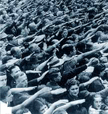 "I created a website where people can leave their mobile phone number. The idea is that when the number of people is large enough, a SMS instruction is sent to all of them simultaneously by the server. When they receive it, people have to perform the instructions. The instructions are simple ones, like raising an arm, but the effect is amplified by the fact that many people do it in the same place, at the same time, as in a symphonic orchestra."
"I created a website where people can leave their mobile phone number. The idea is that when the number of people is large enough, a SMS instruction is sent to all of them simultaneously by the server. When they receive it, people have to perform the instructions. The instructions are simple ones, like raising an arm, but the effect is amplified by the fact that many people do it in the same place, at the same time, as in a symphonic orchestra."
Similarly disturbing is WiFi-SM: Feel the Spectacle of Pain. 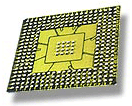 "You have the impression that the disasters of the world do not touch you anymore? You feel vaguely sorry for other people's misfortunes but you don't feel the inner urge which used to make you help your neighbour? WiFi-SM is the solution!"
"You have the impression that the disasters of the world do not touch you anymore? You feel vaguely sorry for other people's misfortunes but you don't feel the inner urge which used to make you help your neighbour? WiFi-SM is the solution!"
Bruno reminds us that, as always, technologies can be abused and/or produce the opposite effects for which they were orginally intended. Or, is this what they were orginally intended to do?
Posted by jo at 10:59 AM | Comments (1)
August 28, 2004
More from the 34North folks
Jeff Knowlton and Naomi Spellman are doing a residency at The Media Centre in Huddersfield. Here's their description of what they are up to:
http://www.druh.co.uk/residencies.html
The work we are developing is an urban exploration shaped from the immediate environment and from online databases. It unfolds in realtime, through space, as the visitor makes her way through the city. The Interpretive Engine creates an audio and visual narrative, relying on the visitors' location and direction – as well as on access to wireless internet connections along the way. The Interpretive engine is a computer-based work, which can be experienced singly or in small groups, either from a visitor's own laptop, or from equipment checked out to visitors. It requires no input from the visitor, other than her natural progression through a loosely delineated space. The project takes into account local surroundings, events, and available telecommunications infrastructure.
Server side data will be parsed in real time from a variety of predetermined online resources, including a news source, a national or metropolitan historic database, a weather source, a local directory, most-wanted international criminal directory, etc. The project will parse and interpret this data, and integrate it into a site specific narrative. Key to this project is a shift in consciousness of the listener, through an exposure of something that is already always present: the [invisible] wireless network. We will encourage visitors to question how informational databases are accessed and controlled in an era of increasingly pervasive corporate and governmental control.
Posted by at 03:01 PM | Comments (0)
August 21, 2004
Mobile Communication, Private Talk, Public Performance
Posted by jo at 10:53 AM | Comments (0)
August 02, 2004
Pedestrian Cinematic Experience
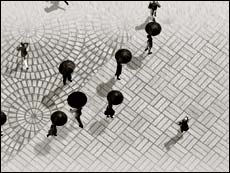
Pedestrian by Shelley Eshkar and Paul Kaiser
February 13 - March 23, 2002:
Pedestrian is a public art project of site-specific, projected installations presented simultaneously in three locations in New York City - in the galleries at Eyebeam in Chelsea and at two outdoor venues; at Rockefeller Plaza in Midtown, and The Studio Museum in Harlem.
Created by artists Shelley Eshkar and Paul Kaiser and co-produced by Eyebeam and Art Production Fund, Pedestrian presents miniature, computer-generated moving figures projected directly onto the ground from above, providing a bird's-eye view of pedestrian traffic. These projected "pedestrians" interact to form patterns, crowds and streams that evolve unpredictably, almost organically, as if having lives of their own. Figures stand, watch, meet, sit, push, move away, sometimes run, or perhaps even lie down according to spontaneous rules of motion and engagement. Pedestrian builds on advanced technology, combining motion-capture, 3-D modeling software, texture mapping to visually enrich surface detail, behavioral rules devised by the artists to drive the action, and an overarching cinematic framework.
Pedestrian depicts a solid and almost tactile world within the pavement you walk upon. It's medium is that of a projected image directly onto the pavement. Instead of a sober rectangle, spectators form a dynamic human perimeter around the work. These are conscious choices to emphasize the work's physicality, and to have our own presence essentially complete the artwork; we and Pedestrian generate a unique crowd footprint in the real world.
By projecting Pedestrian onto public sidewalks, the artists experiment with cinematic experience in the context of public sculpture. Viewers see a bird's eye view of 3D modeled plazas and figures that are mapped with texture samples gathered and scanned from the real world. All movement is built from a library of motion-captured data that is mapped onto synthetic characters. The final projection shows a miniature depiction of real - life motions and the daily public interactions of figures representing various urban archetypes. The distorted foreshortening of an aerial perspective of doll-like figures and plazas are suggestive of surveillance or video games in which we play out constantly changing narratives and dialogue that will continue outside of our current viewpoint
Featured in the ZKM book Future Cinema.
Posted by michelle at 11:19 AM | Comments (0)
August 01, 2004
Mixed Reality in Los Angeles
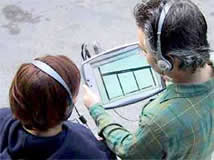
GPS Walkabout
34 North 118 West plays through a Tablet PC with Global Positioning System receiver and headphones. GPS tracks your location to determine how the story unfolds - in real time, in real space, as you traverse the sidewalks of Los Angeles.
Description of Tour: Imagine walking through the city and triggering moments in time. Imagine wandering through a space inhabited with the sonic ghosts of another era. Like ether, the air around you pulses with spirits, voices, and sounds. Streets, buildings, and hidden fragments tell a story. The setting is the Freight Depot in downtown Los Angeles. At the turn of the century Railroads were synonymous with power, speed and modernization. Telegraphs and Railroads were our first cross-country infrastructures, preceding the Internet. From the history and myth of the Railroad to the present day, sounds and voices drift in and out as you walk. Read Narrative Archaeology by Jeremy Hight.
Posted by michelle at 06:07 PM
July 31, 2004
Mobile Culture-Scratching

by Julie Andreyev, at New Forms Festival 2003, consists of 3 cars fitted with video projection on the rear windshield. Each car has a theme determined by the character of the car, and by characteristics of the host city where the fleet is mobilized. The choice of cars for the project reflects the specific car culture of the host city expressed through customization and branding.
Mobile Equipment
The cars are set up with equipment to allow for mobile video downloading, and video mixing using data from the car. While the fleet is mobile, videographers in the downtown site are creating videos for projection on the cars. The themes are used as a guide for them to create footage of the activities of a city's inhabitants.
Networked Process
This footage is uploaded by the videographers onto a web server. Then, the footage is downloaded by the cars as they drive by WIFI (wireless internet) download sites. A sound artist records ambient sound using a microphone held outside the window of one of the cars, mixes this, and plays it back using an FM transmitter. Nearby cars can tune into our frequency and hear the audio sampling. Each car is equipped with a sensor and software patch that interprets data from the car.
Software Interface
For example, one sensor reads data from the engine speed. This data causes a kind of 'jittery' effect to be applied to the video. The faster the car revs, the more 'jittery' the video. In this way, not only are the inhabitants of the city portrayed, but also the car is expressed in the video. After the performance, the cars can be driven into a gallery space where they can be set up to project their archive of the evenings' videos.
Mobile Portrait of the City
The goal of this project is to create a mobile portrait of the city through video and audio sampling of real time events. VJ-Fleet relies on current VJ (or video jockey) culture and the hosting city's local car and social culture. For each performance the project is customized and scaled to reflect the particular nature of the host city.
Posted by michelle at 06:37 PM
Sensing Ubiquitous Computing
Chris Salter's current work presented at the Subtle Technologies Symposium, University of Toronto, Canada, reminds me that we become savvy to knowing that at the ATM, on the roadways and sidewalks, in shops, in elevators, we are being recorded, monitored. We have grown accustomed to speaking publicly in everyday distributed conversations that are publicly private. Yet we ride the subways not seeing each other, cultivating not looking.
Are we so comfortable with the pervasive camera that we would automatically turn away if we didn't wish to have a particular action captured? Can we maintain that awareness in a invisibly sensing environment? How does coming to live comfortably with this change us? Are we aware, or is it just our environment that's aware?
The Edges of Experience-Suspension/Threshold: Sentient Space and Inhabitant-Environment Interaction in the Realm of Ubiquitous Computing by Chris Salter:
"Much recent theorizing concerning bodily extension through technology has largely seen the physical body as a site for machinic intervention. Through prosthetic devices, mechanical, electrical or (more recently), computational implants, theorists have speculated on the blurring of traditional notions of identity as the physical body is mutated, intensified or transformed by technological instruments. Yet, increasingly through ubiquitous/pervasive/ ambient computing paradigms and wireless sensing, artifacts, objects and physical space itself are also being charged with properties traditionally associated with living bodies: tactility, "hapticity" and "skin," sentience, "awareness," and memory. The trajectory towards context-aware computing environments and ambient/responsive media spaces is resulting in two markedly important shifts: a move away from the accepted model of human-computer interaction towards one of environment-inhabitant interaction and an overall rethinking of the cyborg paradigm.
While ubiquitous/ambient/pervasive computing is viewed as the future, the socio-technical repercussions of technologies are rarely focused on. What constitutes a body when space itself becomes "aware" and sentient? What happens to our notions of identity and embodiment when we interact with digital systems; with what Bruno Latour calls "non-human" systems? Who is the subject and who is the object of such interactions or do such traditional notions of fixed identity no longer suffice in computationally-augmented physical environments?
This presentation will concentrate on these issues by focusing on a large scale performance/installation/research project (working title Suspension/Threshold) currently in development. Focusing on the theme of thresholds or bardo (in between) states, the viewers/audience physically move through three different media spaces over the course of a single evening: (1), time-based audio/visual composition, (2) performance for single actor inside a ubiquitous/ambient computing environment driven by a complex wireless sensor network and, (3) responsive environment that lies barely on the threshold of human perception and is interacted with through the aggregate breathing patterns of the collective audience/participants.
Suspension/Threshold both challenges standard notions of body, subject, object, performer and audience as well as poses serious issues for the technical and experiential design of such pervasive or ambient computational spaces within the context of the stage; a stage inhabited by performers and audience members alike."
Also with Sponge.
Posted by michelle at 03:09 PM
